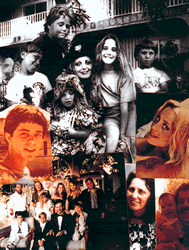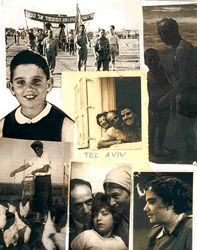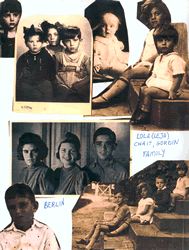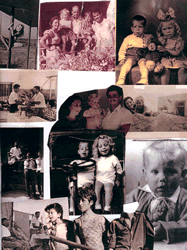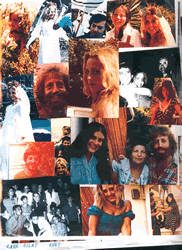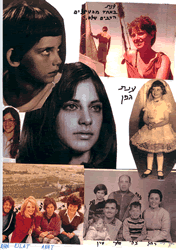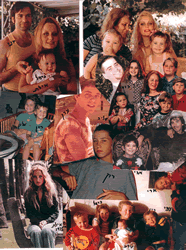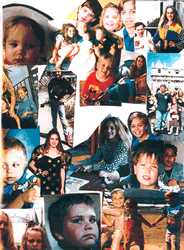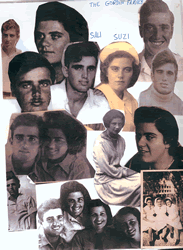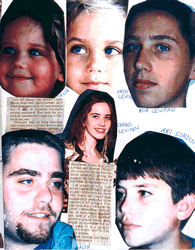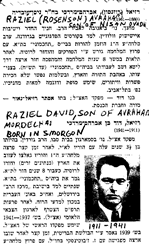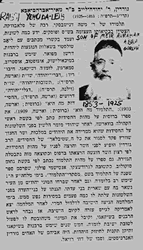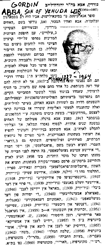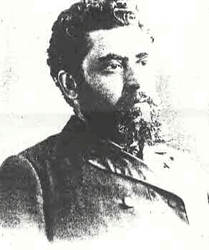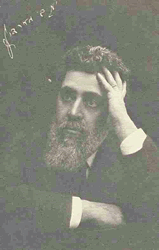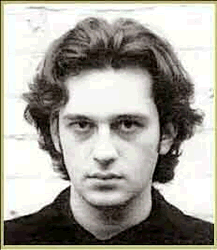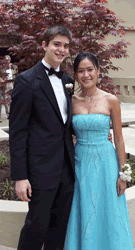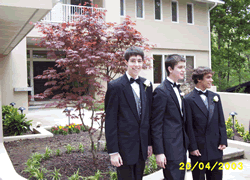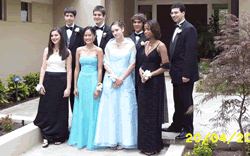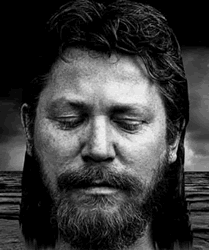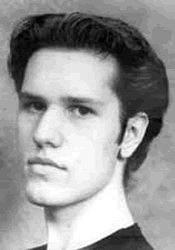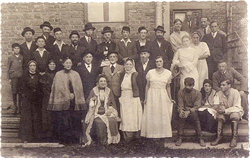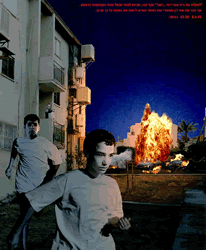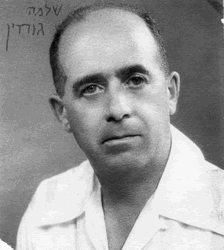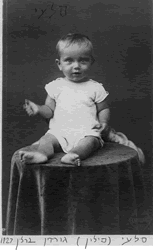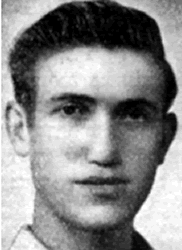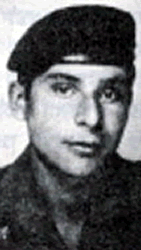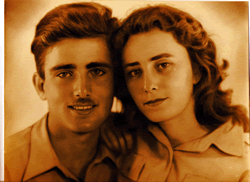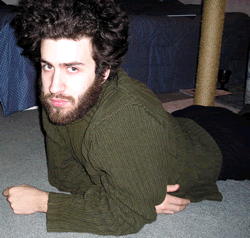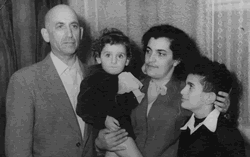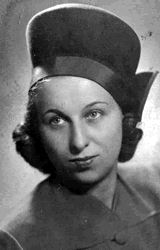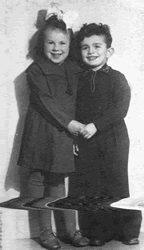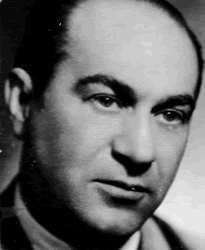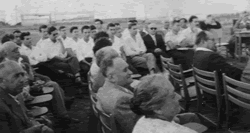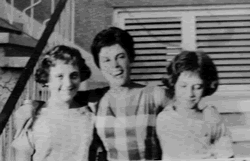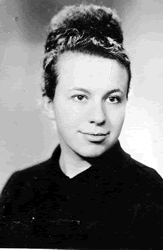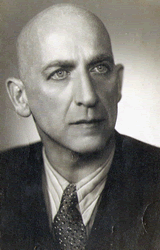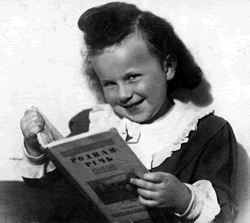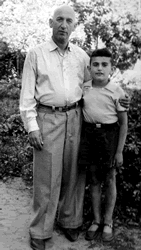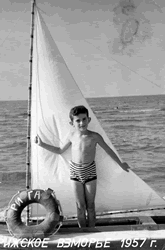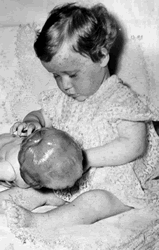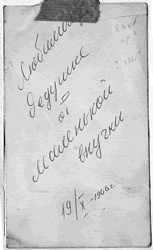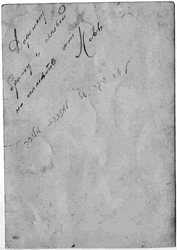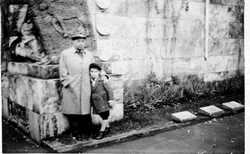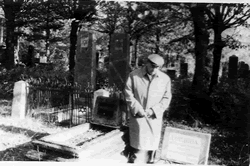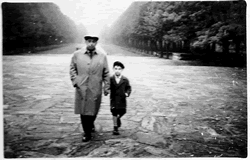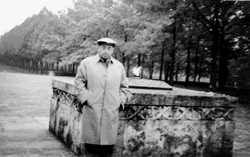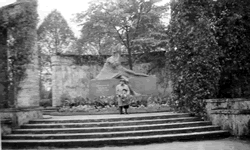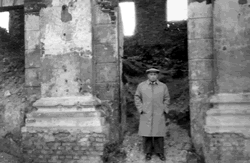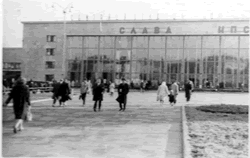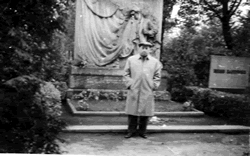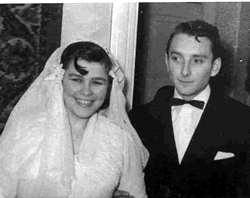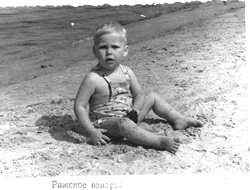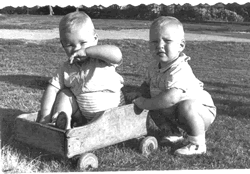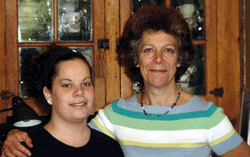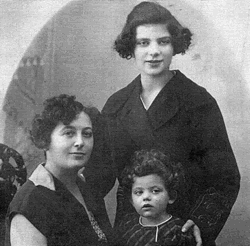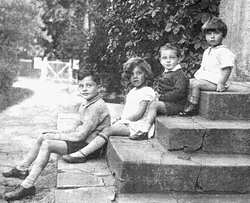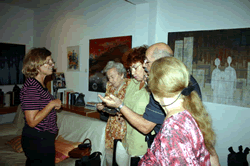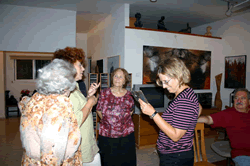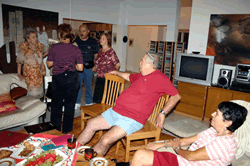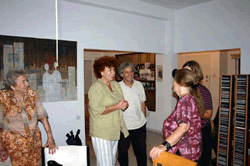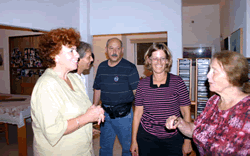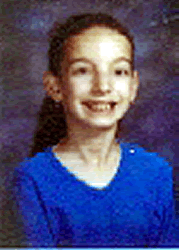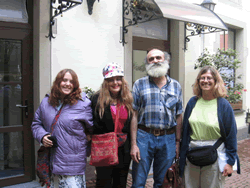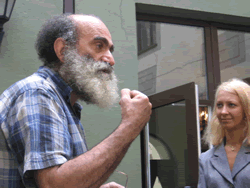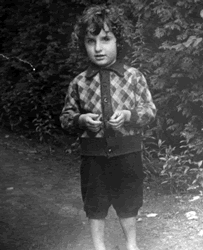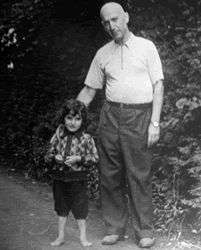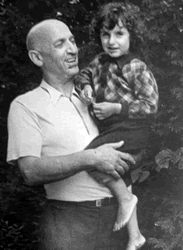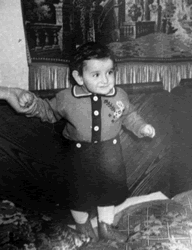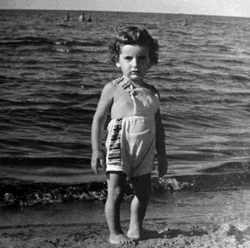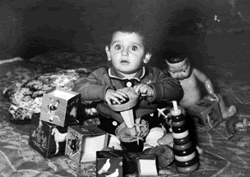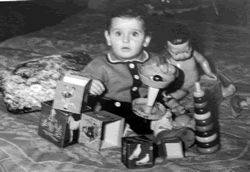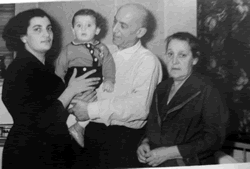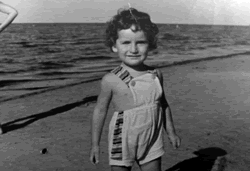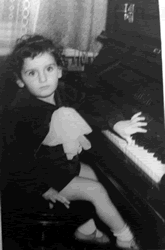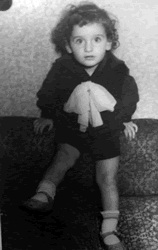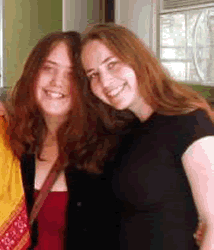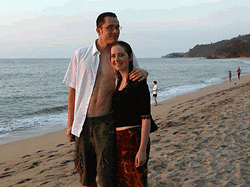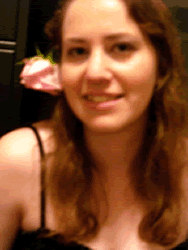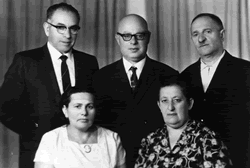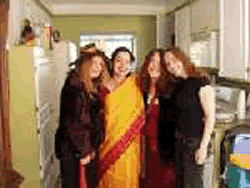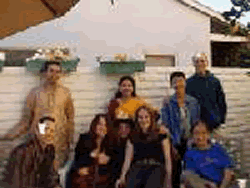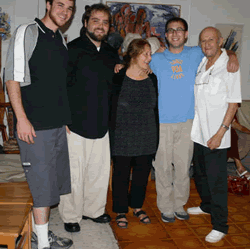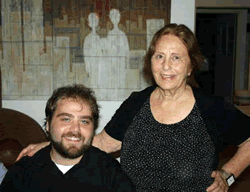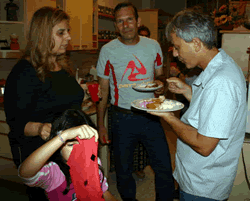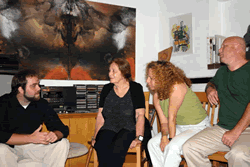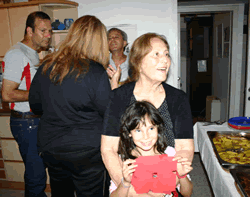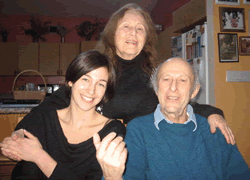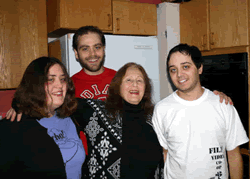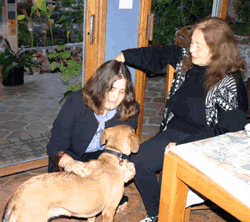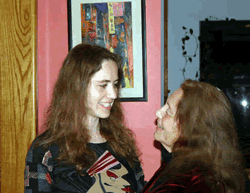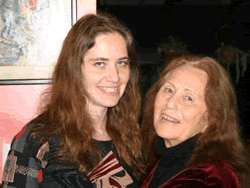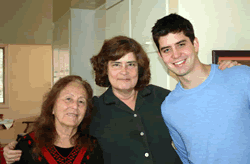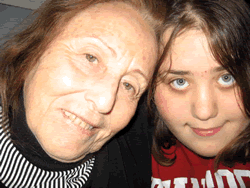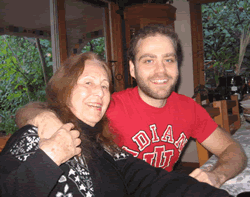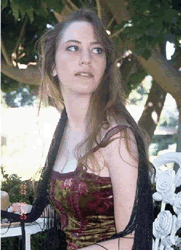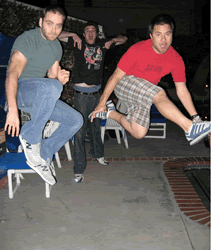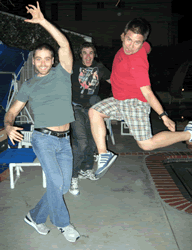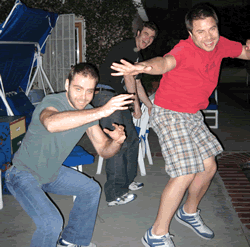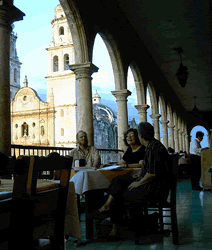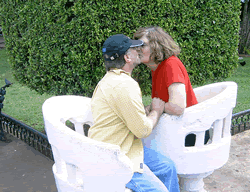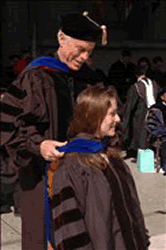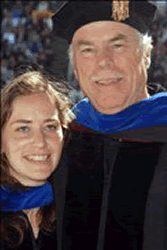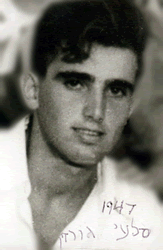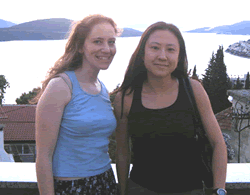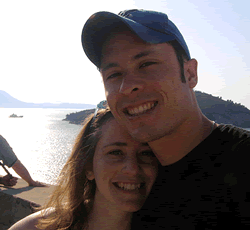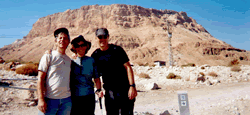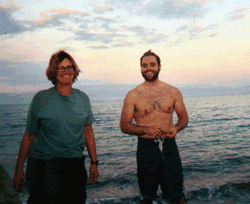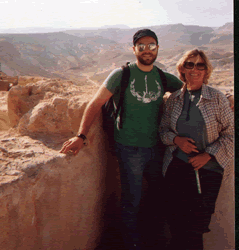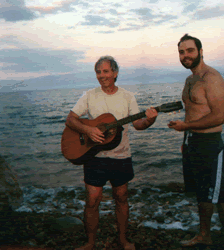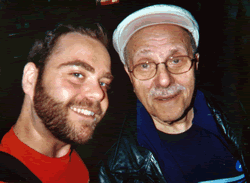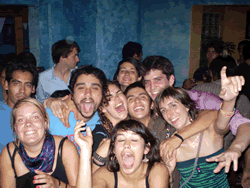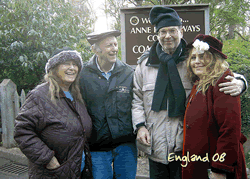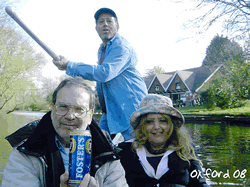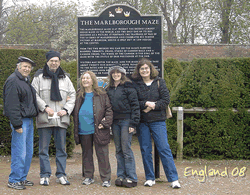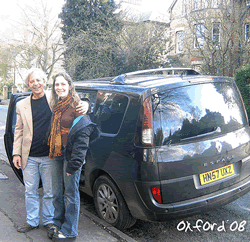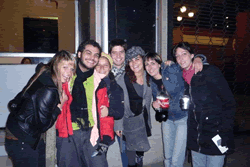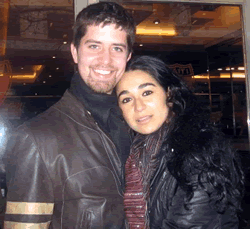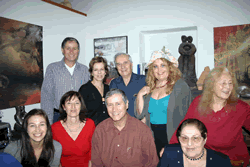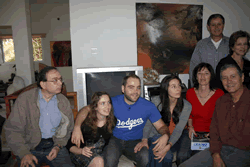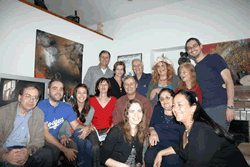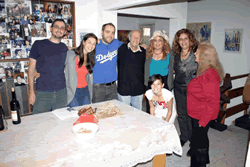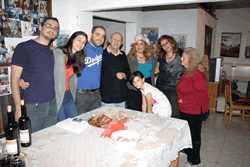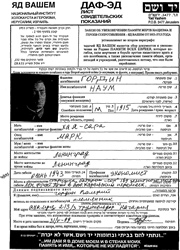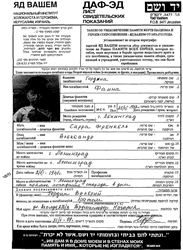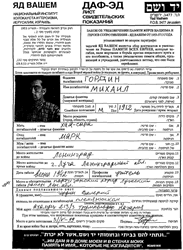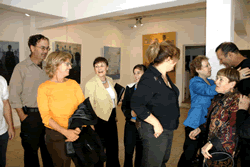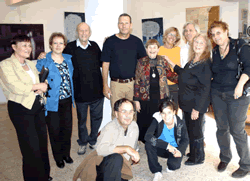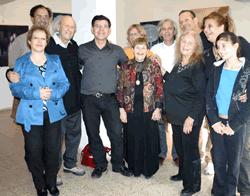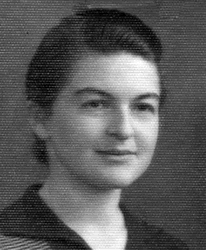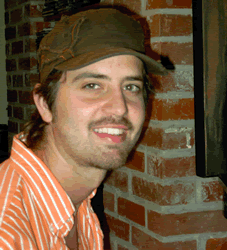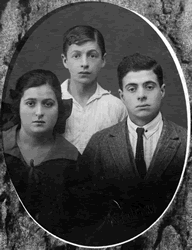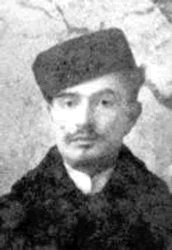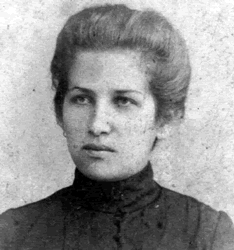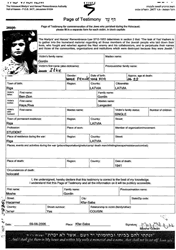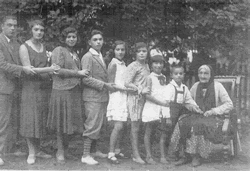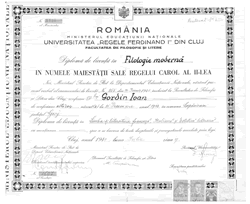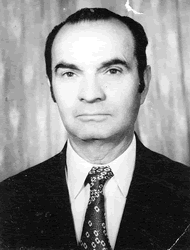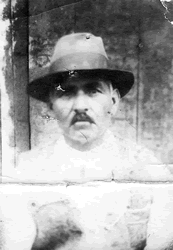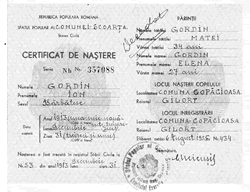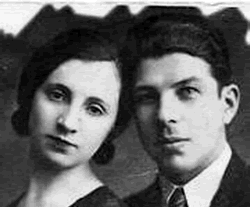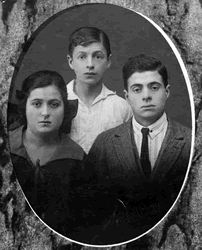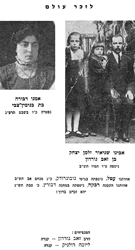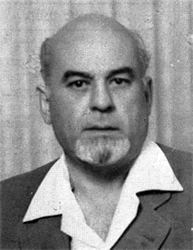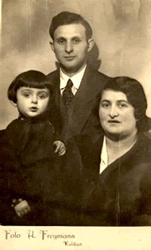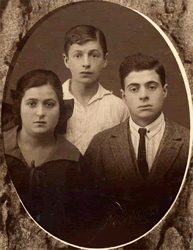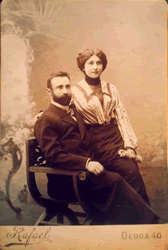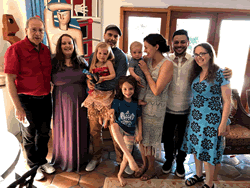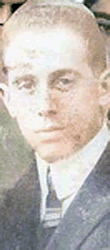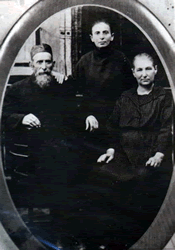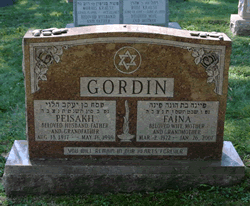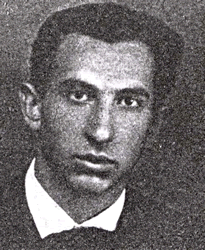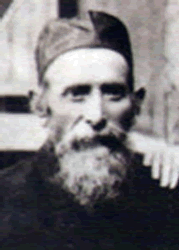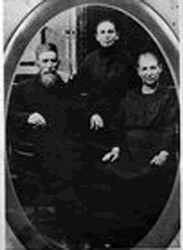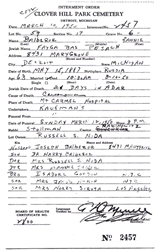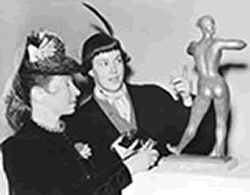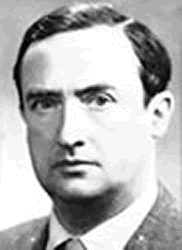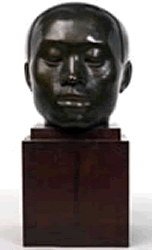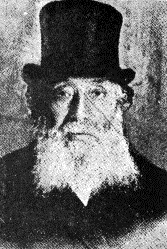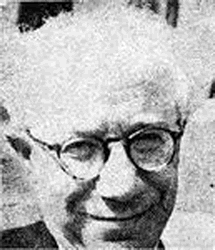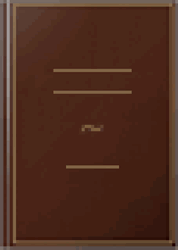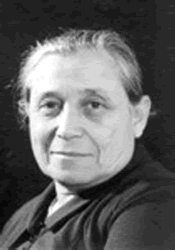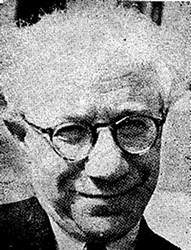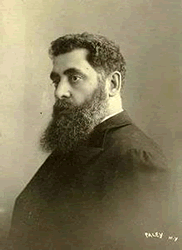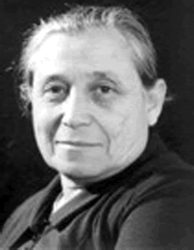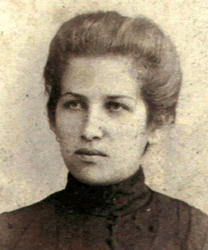Gordin, Jacob Mikhailovich
1853 - 1909, American writer of Yiddish plays, b. Russia. He was for some years a teacher and a newspaper writer in St. Petersburg, Odessa, and elsewhere. In 1880 he founded the Bible Brotherhood, a reform movement of Judaism. After the movement was suppressed, he left Russia in 1891 for the United States. In New York City he found the Yiddish stage in need of good plays, and for the rest of his life he wrote (more than 70), translated, and adapted plays in the vernacular. Among the best of these were Siberia; God, Man, and the Devil; The Jewish King Lear; The Jewish Sappho; and The Kreutzer Sonata (an English translation was produced in 1907). His collected plays were published (1910) in Yiddish in New York.
the magazine of the National Yiddish Book Centre. http://yiddishbookcenter.org/pdf/pt/46/PT46_kaplan.pdf
Rachel Gordin
Our beloved mother Rachel Gordin (daughter of Meir Gurevich and Bella nee Shulman) passed away at her home in Rehovot at around 5PM April 8 2020 as Israelis were getting ready to celebrate zoom Passovers. She was almost 91 years old.
~ Eilat Gordin Levitan
My daughter Talia made- a beautiful memorial video for my mother. She sings and my son Alon plays the piano:
.
https://www.youtube.com/watch?v=JQuWWAhAAJI
There are also some other videos you can find online where my mother speaks about her art and life:
https://www.youtube.com/watch?v=yfueYQ2xKuw&t=40s
Also watch my mother's television segment on the good life:
Gordin home. When he was three, his family immigrated to Eretz Israel and his father became a Hebrew teacher at a Tel Aviv elementary school. When the 1929 Arab riots broke out, he joined the Haganah in Jerusalem, where he was studying philosophy and mathematics at the Hebrew University. When the Irgun was established, he was one of its first members, and displayed outstanding military skills. In 1937 he was appointed Commander of Jerusalem District and a year later Commander in Chief of the Irgun. On May17, 1941 he was sent, with three of his comrades, to Iraq on behalf of the British army. The next day a bomb from a German aircraft killed him.
#gin-18:
Dmitry Gordin was born in 1975 in Moscow, where he attended the Moscow Conservatory High School of Music. He graduated from the Moscow Conservatory in 1999, where his teachers were Profs. E.Schlegova, D.Nemirovsky, and V.Krainev. Gordin has toured to Russia, Ukraine, Israel, Cyprus, Germany, and the US. His repertoire includes works of Scarlatti, Bach, Haydn, Mozart, Beethoven, Schubert, Mendelssohn, Shumann, Chopin, Liszt, Brahms, Tchaikovsky, Scriabin, Rachmaninoff, Ravel, Barber, and Shostakovitch.
#gin-23: Misha
Gordin
www.ablemuse.com/
v3/mgordin.htm
I was born in 1946, the first year after World War II. My parents just
survived hardships of evacuation and returned back home to Riga, now
under Soviet occupation. I grew up among the Russian speaking population
of Latvia, and Russian culture become my root culture. I graduated from
the technical college as aviation engineer but never worked as such;
instead I joined Riga Motion Studios as a designer of equipment for
special effects. I was in my early twenties and mostly ignorant about
art. At this time social realism was an official culture of the country
and I did not care about it too much. Information about modern western
art was hardly available and my knowledge of it was highly limited.
I started to photograph when I was nineteen, driven by desire to create
my own personal style and vision. I was involved in portraiture and
did some documentary shots, but soon realized the results did not satisfy
me..........
In 1972 I created my first, and most important image —
Confession. I instantly recognized the potential possibilities of conceptual
approach, and the knowledge acquired from this image become a backbone
of the work I produced over the next twenty five years. In 1974, after
years of disgust with communist authorities, I left my country and arrived
in USA.
For more details go to;
http://www.geocities.com/sopranist/
picture by brother; Eyal Gordin
Tel Aviv, 1947 LINK
She is the grandaughter of the playwright Jacob Gordin,
a picture of him is on the wall in their hallway
Im 21 and living in greenwhich
conneticut..."
#gin-34:
The lost (to us) family of
Shlomo Gordin ( his siblings and their
children?) in Riga.
Please let us know if you recognize them- Eilat, Tzafi gordin, Anat
Gefen and Eran Gordin eilat.gordinlevitan@gmail.com
#gin-36:
Do you recognize the people ( Gordins of Riga)?
#gin-41:
In the back of the picture
in Russian "To grandfather from your
granddaughter"
#gin-42:
In the back of the picture
in Russian; "To my dear
brother Solomon (Gordin) from your brother ; Lova "( born c 1905)
#gin-44:
Lova Gordin with grand child?
(on the right)
A girl with a Russian book on the left- Do you recognize them?
#gin-45:
The picture of the boy on
boat was taken in 1957 (written in Russian)
Anat Gefen anatgefen@gmail.com
#gin-47& #gin-48
Back of 2 previous pictures Lova & grandfather from 1962?
From the album of Shlomo Gordin of Tel Aviv. Pictures taken during one of Shlomos' visits to Riga and Leningrad during the 1960s' (prior to 1967)
(pictures #gin-51 - #gin-56)
#gin-57:
Mendel Gordin and wife were married in Riga; January 31, 1959
#gin-58:
Son; Isaac was born November 29, 1959, and passed away in 1996
#gin-59:
Sigal and Vered (Twins) were
born in 1965
The family came from Riga to Israel in 1967 and lived in Petah Tikva
until 1982.
#gin-60:
Beth Kaplan, Great granddaughter of Jacob Gordin (the Yiddish playwright), with daughter Anna.
#gin-68: Elianna Gordina
Elianna Gordin ( of San Francisco) is the daughter of Sasha (Alexander) Gordin (born in Riga c 1957). Sasha is the youngest son of Lova Gordin born in Riga in 1904. Lova was the son of Zalman and Frieda . The first family of Lova Gordin perished in the holocaust (his first wife and two children). With second wife (S. Markova) Lova had 2 sons ; Gerik ( see his pictures from Riga) and Sasha.
#gin-69:
Our first meeting with the Gordins of Riga; Talia Levitan, Eilat
Gordin Levitan, Gerik Gordin and Anat Gefen, Riga, summer of 2005
#gin-70:
Gerik Gordin and Lara ? ; Riga, summer of 2005
#gin-82:
Carmel and Talia Levitan, daughters of Eilat Gordin and Daniel Levitan
#gin-83:
Carmel and Josh
#gin-84:
Carmel and Josh in China
#gin-85:
Carmel Levitan
#gin-86:
Carmel and Josh
#gin-87:
Do you recognize the man on the left? he must be GORDIN (or GORDON ).
The photo was taken while he was visiting his relatives in Minsk and
Mocow in the sixties or early seventies. Next to him is his Cousin Lev
Engels (my Grandfather) and on the right is his Cousin Sara Engels.
Gregory Engels
#gin-88:
Carmel, Talia and their mother; Eilat Gordin Levitan with Tandra
#gin-89:
Carmel, Talia and Eilat Gordin Levitan with Josh Fisher and his
family, at the home of Tandra
#gin-90:
Rachel nee Gurevitz Gordin with her grandson; Alon, his friends;
Mike and Loui and rachels' mate; Barak Nachsholi.
#gin-91:
Rachel nee Gurevitz Gordin with her grandson Alon Levitan.
#gin-92:
Eran Gordin with his step sister; Chagit and her husband.
#g93:
Alon and his grandmother Rachel with relatives.
#gin-94:
Rachel Gordin nee Gurevitz with her granddaughter; Leead
#gin-95:
Rachel (nee Gurevitz) Gordin with Barak Nachsholi and Rebbecca (Alon Levitans' friend)
#gin-96:
Rachel (nee Gurevitz) Gordin with grandchildren; Alon, Oren and Talia Levitan.
#gin-97:
Rachel (nee Gurevitz) Gordin with grandchild Talia Levitan and the
dog; Aya.
#gin-98:
Rachel (nee Gurevitz) Gordin with her oldest granddaughter; Carmel
Levitan PhD.
#gin-99:
Rachel (nee Gurevitz) Gordin with her oldest granddaughter; Carmel
Levitan PhD.
#gin-100:
Rachel (nee Gurevitz) Gordin with grandson; Ari Gordin
#gin-101:
Rachel (nee Gurevitz) Gordin with grandson; Ari Gordin and daughter
in law Kathleen Burk ( Gordin)
#gin-102:
Rachel (nee Gurevitz) Gordin with granddaughter; Talia Levitan.
#gin-103:
Rachel (nee Gurevitz) Gordin with oldest grandson; Alon Levitan.
#gin-104:
Carmel Levitan PhD
#gin-105:
Alon with friends 2007
#gin-106:
Alon with friends 2007
#gin-107:
Alon with friends 2007
#gin-108:
Kathleen ( nee Burk) Gordin, her sister Connie and Connie's husband;
Jerry in Mexico. January, 2007
#gin-109:
Tzafy Gordin with his wife; Dr. Kathleen Nee Burk in Mexico, 2007
#gin-110:
Carmel awarded her PhD
#gin-111:
Carmel awarded her PhD
#gin-113:
Carmel and Gerry in Bosnia.
for more pictures go to; http://josh.yosh.org/travel/
#gin-114:
Drs. Joshua B. Fisher and Carmel Levitan in Dubrovnik. http://josh.yosh.org/travel/
#gin-115:
Anat Geffen and her partner Yuda with first cousin
#gin-117:
Alon Levitan and his aunt Anat Geffen
#gin-118:
Eran Gordin and Alon Levitan
#gin-119:
Eran Gordin and Alon Levitan
#gin-121:
Chile, 2008 Ari Gordin ( in a pink shirt) and friends.
#gin-122:
Chile, 2008 Ari Gordin ( second from left) and friends.
#gin-123:
Rachel Gordin, Barak Nachsholi, Daniel Levitan, Eilat Gordin Levitan
#gin-124:
Sitting: Daniel Levitan, Eilat Gordin Levitan Standing: Tzafrir Gordin ( Tzafy)
#gin-125:
From left: Barak Nachsholi, Daniel Levitan, Rachel Gordin, Carmel Levitan, Kathleen Burk ( Gordin)
#gin-126:
Eran Gordin and Carmel Levitan
#gin-127:
Ari Gordin ( middle) with friends (June, 2008).
#gin-128:
Ari Gordin with girl friend; Pauli and Chilean friend: Flaco (June, 2008)
#gin-129:
Ari with Chilean friends (June, 2008)
#gin-130:
Ari Gordin and girlfriend Paulina
#gin-131:
ISRAEL, DECEMBER 2008
#gin-132:
ISRAEL, DECEMBER 2008
#gin-133:
ISRAEL, DECEMBER 2008
#gin-134:
ISRAEL, DECEMBER 2008
#gin-135:
ISRAEL, DECEMBER 2008
#gin-136:
Gordin Naum
Naum Gordin was born in 1915 to Mark and Sara. He was single. Prior to WWII he lived in Leningrad, Russia (USSR). During the war he was in Leningrad, Russia (USSR). Naum perished in 1943 in Russia (USSR). This information is based on a Page of Testimony (displayed on left) submitted on 31-May-1999 by his nephew
#gin-137:
Faina Gordin was born in Leningrad in 1938 to Aleksandr and Sarra. Prior to WWII she lived in Leningrad, Russia (USSR). During the war she was in Leningrad, Russia (USSR). Faina perished in 1941 in Leningrad, Russia (USSR). This information is based on a Page of Testimony (displayed on left) submitted on 31-May-1999 by her brother
#gin-138:
Mikhail Gordin was born in 1912 to Mark and Khaia. He was a teacher. Prior to WWII he lived in Leningrad, Russia (USSR). During the war he was in Luga, Russia (USSR). Mikhail perished in 1942 in Luga, Russia (USSR). This information is based on a Page of Testimony (displayed on left) submitted on 31-May-1999 by his nephew
#gin-139:
FROM LEFT: YEHUDAN AND ANAT ( GEFFEN) DECEMBER 2008 TEL AVIV
#gin-140:
BOTTOM YEHUDA AND LIAD, FROM RIHJT; CHAGIT,RACHEL, ERAN GORDIN, ANAT GEFFEN, GIL, BARAK NACHSHOLI,
#gin-142:
SHARIR-GORDIN AHUVA was born in Vilna in 1927. To read about her go to;
#gin-143:
Ari Gordin returning from Chile; 1- 2- 2009
#gin-144:
Members of the Gordin / Lemchen family.
Yetty Gordin nee Lemchen was born in Kuldiga, Latvia to Baruch and Raina. She was a housewife and married to Jesajahu Gordin. Prior to WWII she lived in Tallin, Estonia. During the war she was in Tallin, Estonia. Yetty was murdered in 1941 in the Shoah at the age of 32. This information is based on a Page of Testimony submitted by her relative, a Shoah survivor.
#gin-145:
Ahron Neta Gordin was born in Dagde, Latvia in 1870 to Moshe and Sara. He was married to Ester nee Astanovski. Prior to WWII he lived in Dagde, Latvia. During the war he was in Dagde, Latvia. Ahron was murdered in 1941 in Dagde, Latvia. This information is based on a Page of Testimony submitted by his son Moshe Gordin.
#gin-146:
Esther Gordin was born in Russia (USSR) in 1870 to Tana and Rachel. She was married to Aharon. Prior to WWII she lived in Dagde, Latvia. During the war she was in Dagde, Latvia. Esther was murdered in 1941 in Dagde, Latvia. This information is based on a Page of Testimony (displayed on left) submitted by her son.
#gin-147:
Etka Gordin was born in Riga, Latvia to Ben zion and Haya nee Lengetzint. She wasmurdered in 1941 in the Shoah.
#gin-148:
Children of Ben zion Gordin and Haya nee Lengetzint. of Riga. Amongst them from left: Moshe, Roza, Etka and Jacob who were murdered in 1941 in the Shoah.
#gin-149:
Roza Gordin was born in Riga, Latvia in 1911 to Ben zion and Riva nee Lengezint. She was a student and single. Prior to WWII she lived in Riga, Latvia. During the war she was in Riga, Latvia. Roza was murdered in 1941 in the Shoah at the age of 30. This information is based on a Page of Testimony submitted by her cousin Moshe Gordin, a Shoah survivor.
Zelda Slutskin (nee Gordin) with husband; Lipman Slutskin#gin-154:
Yetty Gordin nee Lemchen was born in Kuldiga, Latvia to Baruch and
Raina. She was a housewife and married to Yishayahu Gordin. Yetty
perished with her son in Tallin, Estonia in the last months of 1941
at the hands of the Nazis.#gin-155:
#gin-156:
This is my grandmothers, mother, her father and herself with her sister. I had the hebrew translated. I recognize these photos because my grandmother has these exact photos at her home. Her name is Luba Rolnick (Liba Gordon). The pictures are of the Gordon's and I was wondering how they relate to Rolnik other than Luba married my grandfather Avraham Rolnik.
There is a photo of Avraham Rolnik #Rol-1. I don't know if this is my grandfather, as I've never seen a younger picture of him. He was born in 1905 and died in Toronto, ON in 1986. (When I was 7. I am 34 now.) I miss my grandfather SO much and any info you can provide would be so very much appreciated.
Thank you SOOOOO much for making this site! You've made me so happy.
Please write me back at natalierubin@hotmail.com
Sincerely,
Natalie.
Dear Natalie,
The pictures are from the shtetl Ivenetz http://www.eilatgordinlevitan.com/ivenetz/ivenetz.html From the Yizkor book. It is near Minsk and today it is part of Belarus. The Rolnik family in Ivenetz was a large family. Please write about your grandparents. When did they go to Canada? When did Rabbi Zeev Gordon come there?
Thanks,
Eilat
Morris Gordin
Born in 1909 in Riga, Latvia, he tried to escape from the Soviet Union for Eretz Israel in 1947, but was arrested and sentenced to 9 years imprisonment in the Gulag. Released in 1956, he came to Israel in 1963. He died in 19#gin-157:
#gin-158:
The Gordin family was murdered by the Nazis
#gin-159:
Yetti Gordin perished in the holocaust
#gin-160:
Yehuda Leib Gordin ( born in 1867 in Vitebsk) and his wife Malka.
Submitted by Dror Volkhansky
#gin-162:
Solomon/ Zali Shlomo Gordin
#gin-163:
Basia Gordin Engelsgelb with her parents
Faina Gordin; father of Alan P. Gordin of NYC and Vitaly (Maria)
Gordin, MD of Hummelstown, PA; brother of the late Abraham Gordin;
grandfather of Alexis, Yuri and Jacob Gordin. Services were held at
Burton L. Hirsch Chapel, 2704 Murray Ave., Sq. Hill (opp. Morrowfield
Apts.). Interment Beth Shalom Cemetery. Contributions may be madeTo
Congregation Beth Shalom Restoration Fund, Beacon and Shady Ave.,
Pgh., PA 15217.
halperim
http://chfreedman.blogspot.com/2009_06_01_archive.html
Zissa and Pesakh Gordin lived in Berzpils and lost many of their
family in the Holocaust. Their son Yaakov-Zev-Wulf settled in Korsovka
where he was killed by the Nazis together with his children Raisa,
Zalman and Mikhail. The surviving children Liuba Kalinkov, Gitta
Tsiplevitch and Pesakh-Eliyahu settled in Israel. Zissa’s sons Mendel
and Dan also perished in Berzpils. Mendel’s son Aba Gordin survived
and lived in Korsovka. He possessed a Sefer Torah and took upon
himself to organize religious services for the small community that
survived the Holocaust
http://chfreedman.blogspot.com/2009_06_01_archive.html
Peisakh Gordin son of Yaakov
Birth: Aug. 18, 1917
Death: May 16, 1999
Burial:
Beth Shalom Cemetery
Pittsburgh
Allegheny County
Pennsylvania, USA
Plot: Section H
In Yad Vashem I found: Yakov Ze'ev(Wolf) Gordin was born in Berzpils,
Latvia in 1871 to Peisakh and Zisia. He was married to Batya nee Nise.
Prior to WWII he lived in Riga, Latvia. During the war he was in
Karsava, Latvia. Yakov was murdered/perished in 1941 in Karsava,
Latvia. This information is based on a Page of Testimony (displayed on
left) submitted by his daughter Gita Tzepliovich
For her mother: Batja Gordin was born in Latvia in 1881 to Rafail.
She was married to Yakov. Prior to WWII she lived in Riga, Latvia.
During the war she was in Karsava, Latvia. Batja was murdered/perished
in 1941 in Karsava, Latvia. This information is based on a Page of
Testimony (displayed on left) submitted by her daughter Gita.
her brother; Zalman Gordin was born in Berzpils, Latvia in 1915 to
Yaakov and Batia. He was married to Ida nee Silin. Prior to WWII he
lived in Daugavpils, Latvia. During the war he was in Daugavpils,
Latvia. Zalman was murdered/perished in 1941 in Daugavpils, Murder
Site. This information is based on a Page of Testimony (displayed on
left) submitted by his sister Gita.
Ida Gordin nee Silin was born in Daugavpils, Latvia in 1920 to Moshe.
She was married to Zalman. Prior to WWII she lived in Daugavpils,
Latvia. During the war she was in Daugavpils, Latvia. Ida was
murdered/perished in 1941 in Daugavpils, Ghetto. This information is
based on a Page of Testimony (displayed on left) submitted by her
sister-in-law.
Another brother; Mikhail Gordin was born in Berzpils, Latvia in 1918
to Yaakov and Batia. Prior to WWII he lived in Riga, Latvia. During
the war he was in Riga, Latvia. Mikhail was murdered/perished in 1941
in Riga, Ghetto. This information is based on a Page of Testimony
(displayed on left) submitted by his sister Gita.
another sister; Rakhel Ritz nee Gordin was born in Berzpils, Latvia
in 1912 to Zeev and Batia. She was married to Yekhiel. Prior to WWII
she lived in Riga, Latvia. During the war she was in Riga, Latvia.
Rakhel was murdered/perished in 1941 in Riga, Ghetto. This information
is based on a Page of Testimony (displayed on left) submitted by her
sister Gita.
Sincerely,
Eilat
Ilya Gordin was born in Kharkov, Ukraine (USSR) in 1922 to David and
Frida nee Shuval. He was a sekretar raikoma and single. Prior to WWII
he lived in Kharkov, Ukraine (USSR). During the war he was in the
Soviet armed forces. Ilya was killed in military service in 1945 in
Olawa, Germany. This information is based on a Page of Testimony
(displayed on left) submitted by his sister
Ida Gordin
other reports by Ida;
Moisei Gordin was born in Shamki, Belorussia (USSR) in 1900 to Gertz
and Gnesya nee Gurevich. He was a watchmaker and married to Fanya.
Prior to WWII he lived in Kharkov, Ukraine (USSR). During the war he
was in the Soviet armed forces. Moisei was killed in military service
in 1943 in Russia (USSR). This information is based on a Page of
Testimony (displayed on left) submitted by his niece.
Boris Gordin was born in Kholopenichi, Belorussia (USSR) in 1891 to
Hertz and Gnesia. He was an agriculturist and married to Rasia. Prior
to WWII he lived in Minsk, Belorussia (USSR). During the war he was in
Minsk, Belorussia (USSR). Boris was murdered/perished in 1941 in
Minsk, Belorussia (USSR) at the age of 50. This information is based
on a Page of Testimony (displayed on left) submitted by his niece Ida
Gordin
Veniamin Gordin was born in Vyazma, Russia (USSR) in 1918 to Boris. He
was a physician and single. Prior to WWII he lived in Minsk,
Belorussia (USSR). During the war he was in Minsk, Belorussia (USSR).
Veniamin was murdered/perished in 1942 in Belorussia (USSR) at the age
of 24. This information is based on a Page of Testimony (displayed on
left) submitted by his relative.
Rasia Gordin was born in 1896. She was an agriculturist and married to
Boris. Prior to WWII she lived in Minsk, Belorussia (USSR). During the
war she was in Minsk, Belorussia (USSR). Rasia was murdered/perished
in 1941 in Minsk, Belorussia (USSR) at the age of 45. This information
is based on a Page of Testimony (displayed on left) submitted by her
relative.
Birth: 1851
Death: 1942 (91)
Slaveni, Belarus
Immediate Family:
Husband of Galina ... and Frieda Itkin
Father of Basia Engelsgelb; Fanny Balberor; Isaak Gordin; Aaron Gordin; Israel Gordin and 8 others; Malke Gordin; Ronia Gordin and four unknown
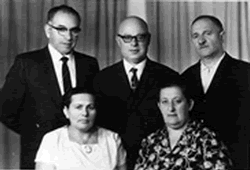
Israel Gordin
Place of Burial: Royal Palm Beach Memorial Garden Cemetery Div C - Sec III - Block 2 - Lot 29, West Plam Beach, FL, USA
Birth: 1896
Russia
Death: March 21, 1991 (95)
West Palm Beach, FL, USA
Son of Peisakh Gordin and Frieda Itkin
Husband of Viola ...
Father of Flora Gordon and Sonia Koff
Brother of Fanny Balberor; Isaak Gordin; Aaron Gordin; Malke Gordin; Ronia Gordin and 6 others
Half brother of Basia Engelsgelb
Basia Engelsgelb (Gordin)
Birth: 1878
Death: 1942 (64)
Slovonich, Belarus
Immediate Family:
Daughter of Peisakh Gordin
Wife of Yosel Engelsgelb
Mother of Lev Engels; Isaak Engelsgelb; Semion Engels; Yakov Engelsgelb; Sara Engelsgelb and 2 others; Samuil Engels and Abram Engels « less
Half sister of Fanny Balberor; Isaak Gordin; Aaron Gordin; Israel Gordin; Malke Gordin and 7 others
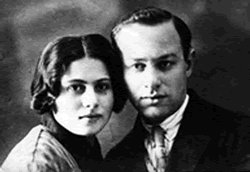
Lev Engels
Birth: January 3, 1903
Minsk, Russia
Death: 1988 (85)
Moskau
Immediate Family:
Son of Yosel Engelsgelb and Basia Engelsgelb
Husband of Riva Engels
Father of Ilja Engels; Sascha Engels; Valentina Engels; Iosif Engels and Grischa Engels
Brother of Isaak Engelsgelb; Semion Engels; Yakov Engelsgelb; Sara Engelsgelb; Samuil Engels and 1 other; and Abram Engels
Dear Eilat,
Thank you for sharing this, but so far it does not match with my Peisakh
but is also not exactly conflicting. "My" Peisakh Gordin has lived from at
least 1900 in Slaveni (near Tolochin, today Belarus). and all of his kids
I know of where born after 1875, and I also have an unconfirmed information,
that he was married more than once. So the people below _could_ be from
his first marriage, but this is a pure speculation.
I am still on the quest of finding the names of all his children, i have found
only half of them so far. I have attached a cemetery record of Fanny Balberor
nee Peisakh Gordin - the record list a "Mrs Jacob Atkin" and "Mrs Harry Sirota"
as her sisters still alive in 1950. This are my hot search topics as of now.
any help?
have a great day!
Grégory Engels
Parkstr. 61 | 63067 Offenbach am Main | Germany
Tel: +49-69-8001242 | Mobil: +49-172-8534491 | Skype: gregory.engels
mailto:Gregory.Engels@kompurity.de | http://www.server-aus-der-steckdose.de
Blog: http://inotes.de
From: eilat levitan <eilat.gordinlevitan@gmail.com>
To: Gregory.Engels@kompurity.de, Eilat Levitan <ed4eilat@yahoo.com>,
Date: 20.02.2013 21:41
Subject: Gordin Family
Peisakh Gordin son of Yaakov
Birth: Aug. 18, 1917
Death: May 16, 1999
Burial:
Beth Shalom Cemetery
Pittsburgh
Allegheny County
Pennsylvania, USA
Plot: Section H
In Yad Vashem I found: Yakov Ze'ev(Wolf) Gordin was born in Berzpils,
Latvia in 1871 to Peisakh and Zisia. He was married to Batya nee Nise.
Prior to WWII he lived in Riga, Latvia. During the war he was in
Karsava, Latvia. Yakov was murdered/perished in 1941 in Karsava,
Latvia. This information is based on a Page of Testimony (displayed on
left) submitted by his daughter Gita Tzepliovich
For her mother: Batja Gordin was born in Latvia in 1881 to Rafail.
She was married to Yakov. Prior to WWII she lived in Riga, Latvia.
During the war she was in Karsava, Latvia. Batja was murdered/perished
in 1941 in Karsava, Latvia. This information is based on a Page of
Testimony (displayed on left) submitted by her daughter Gita.
her brother; Zalman Gordin was born in Berzpils, Latvia in 1915 to
Yaakov and Batia. He was married to Ida nee Silin. Prior to WWII he
lived in Daugavpils, Latvia. During the war he was in Daugavpils,
Latvia. Zalman was murdered/perished in 1941 in Daugavpils, Murder
Site. This information is based on a Page of Testimony (displayed on
left) submitted by his sister Gita.
Ida Gordin nee Silin was born in Daugavpils, Latvia in 1920 to Moshe.
She was married to Zalman. Prior to WWII she lived in Daugavpils,
Latvia. During the war she was in Daugavpils, Latvia. Ida was
murdered/perished in 1941 in Daugavpils, Ghetto. This information is
based on a Page of Testimony (displayed on left) submitted by her
sister-in-law.
Another brother; Mikhail Gordin was born in Berzpils, Latvia in 1918
to Yaakov and Batia. Prior to WWII he lived in Riga, Latvia. During
the war he was in Riga, Latvia. Mikhail was murdered/perished in 1941
in Riga, Ghetto. This information is based on a Page of Testimony
(displayed on left) submitted by his sister Gita.
another sister; Rakhel Ritz nee Gordin was born in Berzpils, Latvia
in 1912 to Zeev and Batia. She was married to Yekhiel. Prior to WWII
she lived in Riga, Latvia. During the war she was in Riga, Latvia.
Rakhel was murdered/perished in 1941 in Riga, Ghetto. This information
is based on a Page of Testimony (displayed on left) submitted by her
sister Gita.
Sincerely,
Eilat
Message: Searched for history of my family and found several references
of
Gordin and Dritz (Drits) on:
http://www.eilatgordinlevitan.com/kurenets/k_pages/gordin_stories_docs.html
My Grandfather - Drits (Dritz) Ruvim was from Dvinsk (Daugavpils) and
my
Grandmother - Gordina Rosa (Roza) (died about 1922) was from Rezekne.
I wonder
if our families are somehow related.
I want to share with you a story of my search for ancestors.
I always been interested in the history of our family, and
loved to listen to my grandpas stories about his childhood.
But I never took notes or did some serious genealogical
research.
My Grandparents died now twenty years ago and since then I
grow up in the belief, that we were very small family and had
not much relatives. And, there were a big mystery about my
grand grandfather, who left his Wife and his 7 Children
right at the beginning of the WWI and disappeared (there are
several different versions, what was happened - the most
realistic is, that he left for another woman)
Then, last year my daughter was born and I took this for a
reason to draw an ancestor chart for her. But, being a
perfectionist as I am, I very soon ended up hooked to this
thrilling task.
I interviewed my oldest living relative, which is a brother
of my grandfather, and after some phone calls he told me, that
his mother, my gg mother had 11 Sisters and one brother who
emigrated to America. Now, that was really big news for
everyone in the family - in the USSR it was dangerous to
have relatives abroad, so nobody spoke about it. And my
grand uncle could not remember a single name, besides that
they where called GORDIN and in America some or all must
have changed it to GORDON.
And then, to my surprise I have found one of the sisters
of my grand grand mother - Malke GORDIN in the Ellis island
database (Passenger ID 101458020010), it is very clear
that she is one of them, because in the cell "closest relative
of the country of origin" she put in my grand grand grand father.
And she was picked up by her sister - Feige BALBIRER, who
lived then (1910) in Brooklyn, 668 Rockaway Av.
And there was also a petition for naturalization number written
on it - 2-262136 10-4-39, but to my disappointment that was it -
I could not go any further.
I am visiting USA now on a business trip for the very first time,
since I have no subscription to Ancestry.com, I went to the
local Library here in Cambridge, MA and worked on their
computer with the ancestry.com data. Thanks to the
www.stevenmorse.org I knew where to look - this whole idea
of ED, WD and AD don't come easy to me. So I found the
BALBIRER Family in the 1910 census and discovered, that
Feigas husband's first name was Joseph, and that he had
a brother Abraham and a sister Sarah living with them as
well as Joseph's father Moishe.
In the 1920 Census I found the family has moved around the
Block to the 560 Stone Av, Brooklyn. They also adopted
American first names calling themselves Joe and Fanny, and
they actually owned the house, but were still on mortgage.
But more important - they had three children - two daughters,
Florence and Sophie and a son named Harry. And, there were
Fanny's brother, Issie GORDON living with them!
This was the first time I have saw his first name, it sounds
strange to me, but what do I know?
I found also some information on Joe's brother Abraham -
I found his Ellis Island manifest (he was born in Slawnoje,
only 5 miles away from where all the sisters were born,
from Slaweni - Senno/Tolochin uezd in Mohilew gubernia)
and found some other sources for him - including a WWI
draft card and a death index - he died 1966 in Detroit, MI.
No trace of Joe and Fanny BALBIRER in the 1930 Census.
How to take it from here?
How to obtain a Naturalization certificate, if I only know
the number of the petition, but not the name of my aunt?
What would be alternatives for the name Issie?
Have anyone ringing a bell?
Now, this is not a really success story yet - but at least,
I don't have an illusion of living in a very small family
anymore - I have now more than 300 persons in my tree, and I
am still at the very beginning.
Gregory Engels, Frankfurt a.M., Germany,
right now in Cambridge, MA +1-617-494-8479 till the July, 1st.
Researching: ENGELS, ENGELSGELB, ZELIKOV, GORDIN, BALBIRER
This is what is known:
Morduch (Mark) GORDIN - the head of the family
Esther GORDIN (nee SCHEPSCHELEVITCH) - his wife. Children:
1. Nikolai (b. 1888) probably in Liepaja, Latvia, killed by Nazis in 1941
in Tallinn, Estonia
2. Anna (b. 1892) probably in Liepaja, Latvia, lived in Tallinn, Estonia.
Probably killed by nazis in 1941/2
3. Leopold (b. 1893) probably in Liepaja, Latvia, lived in Estonia and in
UK
4. Dora (b. probably 1895 in Liepaja, d. 1991 in London) - the famous
sculptor
Would appreciate any additional information.
Mark Rybak, Israel
http://eja.pri.ee/
-------------------------------------------------------------------------------
Dora Gordine: self-taught sculptor, designer, collector and society figure, provides a worthy foil to Epstein. Beginning her career in Paris, where she was encouraged by Maillol, she travelled widely, concentrating from the outset on models of non-European origin. Her bronze bust, The Chinese Philosopher (1926, Dorich House), won her instant acclaim when exhibited in Paris in 1926, and was followed by The Mongolian Head (1927), now in the Tate collection. Her first solo exhibition at the Leicester Galleries in London in 1928, included heads of Indian, Chinese, Cingalese [sic], Javanese, Malay, Iranian and Greek models, and was a complete sell out. Between 1929-35 she lived and worked in the Far East, carrying out a commission from the city of Singapore in 1930 to sculpt six heads representing its constituent races. Dorich House, Kingston Vale, the home she designed in 1936 with her husband Richard Hare, an aristocratic academic, shows her awareness of European Modernsim, but her work, unlike Epstein's, remains classically-inspired.
The exhibition will explore the sculptors shared contacts and interests: both regular exhibitors at the Leicester Galleries, London, and founder-members of the Society of Portrait Sculptors, they also both attracted patronage from the prominent collector Michael Sadler.
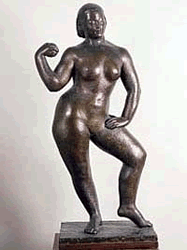
Loans will be drawn from the Ben Uri permanent collection and both private and public sources, including the Tate. Particular support has come from the Garman Ryan Collection at the New Art Gallery, Walsall, and from Dorich House, now part of Kingston University, and home to the Gordine/Hare collection of Russian art and the Gordine archive. Many of Gordine's works have remained unseen for more than fifty years.
The exhibition will be accompanied by a fully-illustrated, colour catalogue with contributions from scholars including Dr. Jonathan Black and Brenda Martin of Kingston University.
Curators: Sarah MacDougall and Rachel Dickson
The Hon Richard Hare (1907-1966) and Dora Gordine (1895-1991)
Dora Gordine at Exhibition in 1949
Richard Hare
Dora Gordine at Exhibition Richard Hare
The newly married Hon Richard Hare and his Latvian born wife, the sculptor Dora Gordine, moved in to Dorich House when it was barely finished in November 1936. The couple designed it themselves and built it with the help of a surveyor/builder, Henry Ivor Cole. It is listed Grade II. The studios, gallery and living spaces they created were unique, providing the perfect environment for a lifestyle devoted to making and collecting art. Achieving a First at Baillol College,Oxford, Richard Hare started a career as a diplomat, but in the mid 1940s he embarked on an ambitious project to built a collection of the then unfashionable art from old Imperial Russia for public ownership. Encouraged by Dora, the collection and study of Russian art and culture became a lifelong passion as he turned to academia, lecturing for the School of Slavonic and Eastern European Studies at the University of London and writing five books and numerous articles on the subject.
Trained in Paris in the 1920s, Dora Gordine achieved overnight fame with a Head of a Chinaman exhibited at the Salon des Tuileries in 1926. The cultures of China and South East Asia were she worked from 1930 – 1935 were constant inspirations for Dora Gordine, influencing both the decoration of her home and her work. Her studies of the human form and portraits in bronze subsequently gained her international fame. She was made a Fellow of the Royal British Society of Sculptors in 1949 and has four heads in the Tate Gallery collection. Following Gordine's death in 1991, Dorich House has become a showcase for Dora Gordine's work and their collection of Russian Imperial Art.
Dora Gordine, was a noted Russian-British sculptress, born in St. Petersburg, Russia (she was never prepared to reveal her year of birth).
She came to Paris to study music and art. Then, surrounded by galleries and salons, she "instinctively felt a correlation between the rhythms of music and sculpture" and developed her sculptural vision.
In 1925 Gordine worked as a painter on a mural for the British Pavilion at the Decorative Arts Exhibition. It provided the means to cast a bronze for exhibition at the Beaux Arts Society. The following year she was invited to exhibit at the Salon des Tuileries where a Torso and head of a Chinese Philosopher received enthusiastic reviews; The Straits Times in 1932 wrote that: - "Like Byron, one morning Dora Gordine woke up famous".
The Leicester Galleries in London presented Gordine's sculpture in a solo show in 1928. It was a huge success and all her work was sold, amongst which Javanese Head was bought by Samuel Courtauld for the Tate Gallery collection.
She married Richard Gilbert Hare (5 September 1907 - 1966), son of Richard Granville Hare, 4th Earl of Listowel and Freda Vanden-Bempde-Johnstone on 21 November 1936. They lived at Dorich House, London. Her husband introduced her to London society figures, many of whom sat for her, Dame Edith Evans, Dame Beryl Grey, Dorothy Tutin, Sian Phillips, Emlyn Williams, Sir Kenneth Clark, John Pope-Hennessy and Professor F. Brown, Head of the Slade School of Art. Each portrait head had its own patina according to Gordine's vision of her sitter. The sculptor commented when interviewed by the BBC in 1972 (Gordine commented that "[w]hen you do portrait busts of somebody you do their noses and mouth - but it is nothing. You have to imagine what they are like inside and bring out their inner feeling and then put it in a form").
During the 40's and 50's Gordine's work was exhibited regularly at the Royal Academy, the Society of Portrait Sculptors and elsewhere. Bronzes from this time have ironic or humorous titles, relating to the pose, such as Great Expectations or Mischief and, of an RAF Officer, Above Cloud. She was elected a Fellow of the Royal Society of British Sculptors in 1949. She occasionally did exotic or "adult" pieces (e.g. for Elizabeth Choy).
In 1960 Esso commissioned a 7' x 5' bas-relief - Power - for their new Milford Haven Refinery, which was unveiled by the Duke of Edinburgh. Gordine's last public commission, the 8' long Mother and Child was made for the entrance hall of the Royal Marsden Hospital, Surrey, in 1963.
Richard Hare's sudden death in 1966 from a heart attack left Gordine to live out her life alone in Dorich House. They had had no children. She never fully recovered emotionally and her career ended in the 1970s. She died in Dorich House in December 1991.
[1] Ben Uri Gallery
Nationality and
Naturalisation
HO 144/12019 1930 Nationality and Naturalisation:
Gordin, Leopold, from Latvia.
Resident in London. Certificate
19025 issued 25 November 1930
EMBRACING THE EXOTIC: JACOB EPSTEIN & DORA GORDINE. Ben Uri Gallery, London Jewish Museum of Art, 2006. Published in association with Papadakis Publisher, London. Distributed in the U.S.A. by Antique Collectors' Club, Easthampton. 80 pp. with 83 ills. (56 col.). 30 x 22 cm. ISBN 1901092631. In English.
Artist(s): Epstein, Jacob; Gordine, Dora
Indexing: _Western_ _Europe_ _Great Britain_ _1900-1945_ _Sculpture_ _Drawing/Watercolor_ _Women Artists_
Plans: 73 75
Worldwide Number 067523
As Dora Gordine and Richard Hare died without an heir,the executors of their estate entrusted the house and its contents to Kingston University to provide a permanent home for the sculpture of Dora Gordine and the Russian art collection of Richard Hare.
From Yad Vashem all "Gordins" from "Estonia":
Gordin Yaakov
Yaakov Gordin was born in Kuldiga in 1930 to Jeschajahu and Jetty. Prior to WWII he lived in Tallin, Estonia. During the war he was in Tallin, Estonia. Yaakov perished in 1941 in Tallinn, Estonia. This information is based on a Page of Testimony (displayed on left) submitted on 12-Sep-1999 by his cousin
Gordin Yetty
Yetty Gordin nee Lemchen was born in Kuldiga to Baruch and Raina. She was a housewife and married to Jesajahu. Prior to WWII she lived in Tallin, Estonia. During the war she was in Tallin, Estonia. Yetty perished in 1941 in the Shoah at the age of 32. This information is based on a Page of Testimony (displayed on left) submitted on 13-Sep-1999 by her relative, a Shoah survivor who lives in Berlin;
Submitter's Last Name RAGOLSKY
Submitter's First Name BETTY
Gordin Sheva
Sheva Gordin nee Goldberg was born in Parnu, Estonia in 1893 to Zusman and Rokhl. She was a housewife and married to Iakov. Prior to WWII she lived in Parnu, Estonia. During the war she was in Novosibirsk, Russia (USSR). Sheva perished in 1944 in Novosibirsk, Russia (USSR) at the age of 51. This information is based on a Page of Testimony (displayed on left) submitted by her daughter Chaia GORDINA
Results of search for victims whose family name (including synonyms) is 'Gordin' , and whose location (including synonyms) is 'Latvia' :
Displaying 1 - 82
Place of Residence
Name Town District Region Country Birth Date Source
Gordin Aharon DAGDE DAUGAVPILS LATGALE LATVIA 1870 Page of Testimony
Gordin Mikhael RIGA RIGAS VIDZEME LATVIA 1918 Page of Testimony
Gordin Zeev RIGA RIGAS VIDZEME LATVIA 1894 Page of Testimony
Gordon Keila DVINSK DAUGAVPILS LATGALE LATVIA 1935 Page of Testimony
Gordin Zalman DAUGAVPILS DAUGAVPILS LATGALE LATVIA 1915 Page of Testimony
Gordin Nadja RIGA RIGAS VIDZEME LATVIA 1911 Page of Testimony
Gordin Rakhel RIGA RIGAS VIDZEME LATVIA 1895 Page of Testimony
Gordin Khana RIGA RIGAS VIDZEME LATVIA 1877 Page of Testimony
Gordin Ester DAGDA DAUGAVPILS LATGALE LATVIA 1880 List of Persecuted
Gordin Raiza DAGDA DAUGAVPILS LATGALE LATVIA 1902 List of Persecuted
Gordins Elle RIGA RIGAS VIDZEME LATVIA List of Persecuted
Gordins Rakhile RIGA RIGAS VIDZEME LATVIA 1884 List of Persecuted
Gordins Khayme RIGA RIGAS VIDZEME LATVIA 1888 List of Persecuted
Gordins Zara RIGA RIGAS VIDZEME LATVIA 1912 List of Persecuted
Gordins Yudits RIGA RIGAS VIDZEME LATVIA 1926 List of Persecuted
Shlyakhter Yudif REZEKNE REZEKNES LATGALE LATVIA Page of Testimony
Gordin Bunia RIGA RIGAS VIDZEME LATVIA 1926 Page of Testimony
Gordin Dina RIGA RIGAS VIDZEME LATVIA 1910 Page of Testimony
Gordin Zeev RIGA RIGAS VIDZEME LATVIA Page of Testimony
Gordin Sonya RIGA RIGAS VIDZEME LATVIA Page of Testimony
Gordin DVINSK DAUGAVPILS LATGALE LATVIA 1938 Page of Testimony
Janowski Roza RIGA RIGAS VIDZEME LATVIA Page of Testimony
Gordin Hirsh DVINSK DAUGAVPILS LATGALE LATVIA 1934 Page of Testimony
Gordin Zelda DVINSK DAUGAVPILS LATGALE LATVIA Page of Testimony
Gordin Yudel RIGA RIGAS VIDZEME LATVIA 1913 Page of Testimony
Gordin Yaakov RIGA RIGAS VIDZEME LATVIA 1879 Page of Testimony
Gordin Gershon DVINSK DAUGAVPILS LATGALE LATVIA 1900 Page of Testimony
Gordin Yaakov TALLIN HARJUMAA ESTONIA 1930 Page of Testimony
Gordin Yetty KULDIGA KULDIGAS KURZEME LATVIA Page of Testimony
Gordin Aron DAGDA DAUGAVPILS LATGALE LATVIA 1881 List of Persecuted
Gordin Solomon RIGA RIGAS VIDZEME LATVIA 1909 Page of Testimony
Gordin Tzera REZEKNE REZEKNES LATGALE LATVIA Page of Testimony
Gordin Wolf RIGA RIGAS VIDZEME LATVIA 1888 Page of Testimony
Gordin Bertha RIGA RIGAS VIDZEME LATVIA 1881 Page of Testimony
Gordin Ela DVINSK DAUGAVPILS LATGALE LATVIA Page of Testimony
Gordin Gershon DVINSK DAUGAVPILS LATGALE LATVIA Page of Testimony
Gordin Jacob RIGA RIGAS VIDZEME LATVIA 1879 Page of Testimony
Gordin Sara RIGA RIGAS VIDZEME LATVIA 1910 Page of Testimony
Gordin RIGA RIGAS VIDZEME LATVIA Page of Testimony
Gordin Khaia DVINSK DAUGAVPILS LATGALE LATVIA Page of Testimony
Gordin Esther DAGDE DAUGAVPILS LATGALE LATVIA 1870 Page of Testimony
Gordin Judith RIGA RIGAS VIDZEME LATVIA 1925 Page of Testimony
Gordin Matl RIGA RIGAS VIDZEME LATVIA Page of Testimony
Gordin Shmuel DVINSK DAUGAVPILS LATGALE LATVIA Page of Testimony
Gordin Chajim DVINSK DAUGAVPILS LATGALE LATVIA Page of Testimony
Gordin Tzila KRASLAVA DAUGAVPILS LATGALE LATVIA 1929 Page of Testimony
Gordin Yaakov RIGA RIGAS VIDZEME LATVIA 1871 Page of Testimony
Rich Rakhel RIGA RIGAS VIDZEME LATVIA 1912 Page of Testimony
Gordin Genadia RIGA RIGAS VIDZEME LATVIA 1910 Page of Testimony
Gordin Khaia KRASLAVA DAUGAVPILS LATGALE LATVIA 1902 Page of Testimony
Gordin Sara VARAKLANI REZEKNES LATGALE LATVIA 1902 Page of Testimony
Blekhman Sara RIGA RIGAS VIDZEME LATVIA 1878 Page of Testimony
Gordin Ela DAUGAVPILS DAUGAVPILS LATGALE LATVIA 1903 Page of Testimony
Gordin Ida DAUGAVPILS DAUGAVPILS LATGALE LATVIA 1920 Page of Testimony
Gordin Nissel RIGA RIGAS VIDZEME LATVIA 1881 Page of Testimony
Gordin Golda VILANI REZEKNES LATGALE LATVIA Page of Testimony
Gordin Monja LATVIA Page of Testimony
Gordin Penekh KRASLAVA DAUGAVPILS LATGALE LATVIA 1932 Page of Testimony
Gepshtein Slava REZEKNE REZEKNES LATGALE LATVIA 1907 Page of Testimony
Gordin Pesia VARAKLANI REZEKNES LATGALE LATVIA 1926 Page of Testimony
Gordin Sara VARAKLANI REZEKNES LATGALE LATVIA 1896 Page of Testimony
Gordin Kopel VARAKLANI REZEKNES LATGALE LATVIA 1930 Page of Testimony
Gordin Kopel VARAKLANI REZEKNES LATGALE LATVIA 1930 Page of Testimony
Gordin Moshe VARAKLANI REZEKNES LATGALE LATVIA 1901 Page of Testimony
Gordin Moshe VARAKLANI REZEKNES LATGALE LATVIA 1896 Page of Testimony
Gordin Shimen KRASLAVA DAUGAVPILS LATGALE LATVIA 1926 Page of Testimony
Gordin Hessa VARAKLANI REZEKNES LATGALE LATVIA 1928 Page of Testimony
Gordin Rakhmiel LATVIA 1918 Page of Testimony
Gordin Zevulun KRASLAVA DAUGAVPILS LATGALE LATVIA 1936 Page of Testimony
Aronowicz Henia RIGA RIGAS VIDZEME LATVIA 1870 Page of Testimony
Gordin David LENINGRAD LENINGRAD LENINGRAD RUSSIA (USSR) 1887 Page of Testimony by daughter; Submitter's Name; GORDIN DINA
Gordin Hesa VARAKLANI REZEKNES LATGALE LATVIA 1928 Page of Testimony
Gordin Motl KRASLAVA DAUGAVPILS LATGALE LATVIA 1900 Page of Testimony
Gordin Pesia VARAKLANI REZEKNES LATGALE LATVIA 1926 Page of Testimony
Gordin Tzalel REZEKNE REZEKNES LATGALE LATVIA Page of Testimony
Jewish Survivor
Question Answer
Name of Interviewee Gilel' Gordin
Gilel' Gordin (release name)
Hilel Gordon (other name)
Gilel' Itskhak Gordin (other name)
Gender Male
Date of Birth 8/22/1923
City of Birth Riga (Latvia)
Country of Birth Latvia
Religious Identity (Prewar) observant/practicing
Religious Identity (Postwar)
Religious Identity (Time Period Unknown)
Ghetto(s) Riga (Latvia : Ghetto)
Theresienstadt (Czechoslovakia : Ghetto)
Camp(s) Riga-Kaiserwald (Latvia : Concentration Camp)
Dachau (Germany : Concentration Camp)
Buchenwald (Germany : Concentration Camp)
Stutthof (Danzig (FC) : Concentration Camp)
Bochum (Germany : Concentration Camp)
Went into Hiding
Member of Underground, Resistance or Partisan Group(s) Yes
Hiding or living under false identity (Location) Buchenwald (Germany : Concentration Camp)
Type of hiding place buildings
Resistance Group(s)
Liberated by armed forces, Soviet
Location of liberation Theresienstadt (Czechoslovakia : Ghetto)
Fled from Nazi controlled territory No
Forced (death) Marches Yes
Aid Giver, Liberator, or War Crimes Trials Participant
Other Experiences forced labor: body removal and disposal
evasion of roundups
concealment of Jewish identity
State of Interview Central
Country of Interview Israel
Language(s) of Interview Russian
Length of Interview 1:50
Interview Code 6416
--Gordin, Leika
Jewish Survivor
Question Answer
Name of Interviewee Leika Gordin
Leika Mordkovna Gordin (release name)
Gordin (current name)
Leika Mordkovna Ialanetskaia (name at birth)
Ilanetskaia (last name during war)
Ilanetskaia (maiden name)
Liza (other name)
Ialanetskaia (release maiden name)
Gender Female
Date of Birth 6/16/1929
City of Birth Velikaia Kosnitsa (Ukraine, USSR)
Country of Birth USSR
Religious Identity (Prewar) Judaism
Religious Identity (Postwar) Judaism
Religious Identity (Time Period Unknown)
Ghetto(s)
Camp(s)
Went into Hiding No
Member of Underground, Resistance or Partisan Group(s) No
Hiding or living under false identity (Location)
Type of hiding place
Resistance Group(s)
Liberated by armed forces, Soviet
Location of liberation Velikaia Kosnitsa (Ukraine, USSR)
Fled from Nazi controlled territory No
Forced (death) Marches No
Aid Giver, Liberator, or War Crimes Trials Participant
Other Experiences Romanian colony
State of Interview
Country of Interview Ukraine
Language(s) of Interview Russian
Length of Interview 0:00
Interview Code 49613
Gordin, Mikhail
Jewish Survivor
Question Answer
Name of Interviewee Mikhail Gordin
Mikhail Isakovich Gordin (release name)
Gordin (current name)
Mikhail Itskovich Gordin (name at birth)
Gordin (last name during war)
Meer (Yiddish name)
Gender Male
Date of Birth 5/15/1936
City of Birth Floresti (Soroca, Bessarabia, Romania)
Country of Birth USSR
Religious Identity (Prewar) Judaism
Religious Identity (Postwar) Judaism
Religious Identity (Time Period Unknown)
Ghetto(s) Miastkovka (Ukraine, USSR : Ghetto)
Camp(s)
Went into Hiding No
Member of Underground, Resistance or Partisan Group(s) No
Hiding or living under false identity (Location)
Type of hiding place
Resistance Group(s)
Liberated by resistance fighters, Soviet
Location of liberation Miastkovka (Ukraine, USSR)
Fled from Nazi controlled territory No
Forced (death) Marches No
Aid Giver, Liberator, or War Crimes Trials Participant
Other Experiences
State of Interview
Country of Interview Moldova
Language(s) of Interview Russian
Length of Interview 1:00
Interview Code 30005
Gorodinskaia, Raisa
Jewish Survivor
Question Answer
Name of Interviewee Raisa Gorodinskaia
Raisa Abramovna Gorodinskaia (release name)
Gorodinskaia (current name)
Resha Beshkina (name at birth)
Beshkina (last name during war)
Raisa Gordinski (other name)
Beshkina (release maiden name)
Gender Female
Date of Birth 10/13/1925
City of Birth Dereczyn (Nowogródek, Poland)
Country of Birth Poland
Religious Identity (Prewar) traditional Judaism
Religious Identity (Postwar) traditional Judaism
Religious Identity (Time Period Unknown)
Ghetto(s) Dereczyn (Poland : Ghetto)
Camp(s)
Went into Hiding Yes
Member of Underground, Resistance or Partisan Group(s) Yes
Hiding or living under false identity (Location) Lipiczany Forest (Poland)
Dereczyn (Nowogródek, Poland)
Type of hiding place attics
forests
Resistance Group(s) Otriad Pobeda
Atlas Otriad
Liberated by armed forces, Soviet
Location of liberation Nowogródek (Poland : Voivodship)
Fled from Nazi controlled territory No
Forced (death) Marches No
Aid Giver, Liberator, or War Crimes Trials Participant
Other Experiences evasion of roundups
escapes from the ghettos
State of Interview Southern
Country of Interview Israel
Language(s) of Interview Russian
Length of Interview 2:30
Interview Code 33000
46897 Gorodinskaia, Dina Russian
> I'm interested in getting in touch with Moshe Gordon's family - if there is any - in the hope of learning about his (and Robinson's) years in Warsaw and/or finding some documents either from the period (university degrees, photographs etc.) or from later years (correspondence between Robinson and Gordon etc.).
> Do you have any idea how I could find out whether there is any family left and, if yes, where she might be?
>
> Many thanks,
>
> Omry Kaplan-Feuereisen
Shalom Omri,
Please let me know what you found out
From Family tree of the Jewish people:
Moshe GORDON ( son of Shmuel Leib GORDON )
Born: 1892, Jaffa, Israel
Died: 1974
Children:
Yoram Rami GORDON, Living. Spouse: Judith GESELOWITZ, Living Children:
1. Gilad Shalag GORDON, Living Spouse: Claire YARMO, Living
Children:
Oren Moshe GORDON, Living.
Robert Marvin GORDON, Living.
Arial Steven GORDON, Living
2. Liran Alon GORDON, Living.
Googling the name:
Gilad Shalag Gordon, MD
Specialty:Internal Medicine
Major Activity:Research
Graduation:Harvard Med Sch, Boston Ma 02115, (1983)
Residency:Univ Wa Med Ctr, Internal Medicine; Univ Of Co Sch Of Med,
Internal Medicine
Location:1565 Rockmont Cir
Boulder, CO 80305
Phone: 303-494-4102
WEDDINGS; Liran Gordon and Karen Appelbaum
Published: May 31, 1993
Karen A. Appelbaum and Liran A. Gordon, both lawyers in Washington,
were married yesterday in Roslyn, L.I. Rabbi Aaron Petuchowski
performed the ceremony at Temple Sinai.
The bride, who works in the office of the general counsel at the
Federal Reserve Board, graduated from the University of Pennsylvania
and received her law degree from American University. She is the
daughter of Barbara and Robert Appelbaum of Roslyn. Her father is a
director of apparel and mill marketing at Cotton Inc., a marketing and
research organization in New York. Her mother is the program
coordinator at North Shore Child and Family Guidance, an outpatient
mental-health clinic in Manhasset, L.I.
Mr. Gordon is an associate in the law firm of Covington & Burling. He
graduated from Harvard University and received M.B.A. and law degrees
from the University of Pennsylvania. He is a son of Dr. Yoram Gordon
and Judith Gordon of Reston, Va. His mother is the president of Gordon
Resources Consultants, a medical waste management consulting firm in
Reston. His father is a regional vice president at Greenhorn & O'Mara
Inc., an engineering consulting firm in Greenbelt, Md.
facebook Name: Oren GordonNetworks: Boulder, CO Claremont Colleges '12
Ari GordonClaire Gordon
Claire Gordon
Boulder, CO
Add as Friend
Zoe Gordon
High School '10
Denver, CO
Networks:Cherry Creek High School '10
Denver, CO
From: Patricia Vlad <vladpatricia@yahoo.com>
Dear Eiliat,
I have read and I was impressed by your study regarding the GORDIN
family tree. I found out about it while I was searching for the name
Gordin. Why? Because my name is also GORDIN.
My grandfather was GORDIN MATEI – born I don’t know where, because in
the village he lived there was just a cousin with the same name,
without trace or ancestors wih the same name. He was making commerce
between Tg Jiu and Bucharest. In 1913 when he was 34 my grandfather
was born, GORDIN ION. In 19…. he was sent to study in Satu Mare to
study. He finished the Officers School and the Letters Faculty
(Languages). After serving in the armed forces he became a professor
of French.
His daughter Gordin Adina, my mother is a medical doctor and a
university Assistant at the Medical School in Bucharest. Her daughters
are Vlad Craoveanu Gordin Ana Patricia (me) and Luca Laura Margareta
(my sister).
The existence of a relationship with the ancestors found by you can be
real - if my imagination does not play with me by the form of the
eyebrows in some of the pictures you posted on the website. With the
same remark I send you the picture of my grandfather and my
great-grandfather which in my opinion resembles strongly with some of
the pictures posted by you on the website.
I also send you some documents that my mother has and maybe you can
help me find out from which side of this big family we come from.
Anyways the family has a branch in Romania. I couldn’t find the name
Gordin anywhere else in Romania. In accordance with your information I
will ass that all the members that I know finished university. I am
currently studying a Double Degree in International Business between
Hungary and Italy.
From my grandmothers side there is a branch in the USA as well at
least from what I could find.
I really hope you will not find this email strange and maybe with the
information I gave you, you will be able complete the family tree and
I will find out more about my roots.
Kind regards,
Patricia
The Gordin/ Rosenson- Raziel Family of Smorgon
Rabbi Yehuda Leib Gordin,
RABBI GORDIN DIES SUDDENLY AT HIS PRAYERS Birth: 1854 Death: Apr. 11, 1925
Chief Rabbi Jehuda Leib Gordin, head of the Chicago Orthodox Rabbinical association, last night stood at his wall in the old fashion of the patriarchs and said his evening prayer. He was 71 years old. Years of pursuit of knowledge – the rabbi is rated by his race as one of its greatest Hebrew scholars – and the toil of his religious service has weakened his heart.
As he softly intoned the sonorous prayers for the evening, his voice quavered into silence. The venerable body slid to the floor. Heart disease was the cause of death. Rabbi Gordin had charge of the Tisereth Zion synagogue. He had written many books and had achieved fame in Jewish circles on an international scale. Chicago Daily Tribune – April 12, 1925
FUNERAL TODAY FOR RABBI GORDIN; 35,000 WILL JOIN CORTEGE
Funeral services for the late Rabbi Yehuda Leib Gordin, dean of the orthodox rabbinical association of Chicago and chief rabbi of the city will be held today in accordance with arrangements completed at a meeting yesterday afternoon of representatives of more than a hundred Jewish organizations at Tifereth Zion Shul, the synagogue where the rabbi officiated.
More than 35,000 people are expected to be in the funeral cortege,
including all rabbis from within a day's ride of the city and many members of their congregations. The line of march will proceed from the residence at 1401 North Hoyne avenue, to the synagogue at 1243 North Lincoln street.
Services will be held while the body, following an ancient custom of the Jews, remains outside the synagogue.
Enroute to the Tifereth Zion cemetery on Roosevelt road, the funeral will halt in front of the Beth Hamedrash L'Horah, the training school for rabbis, of which Rabbi Gordin was dean. Chicago Daily Tribune – April 13, 1925
10,000 JEWS PAY TRIBUTE TO LATE RABBI GORDIN
Ten thousand Jews yesterday stood in silent prayer in Tifereth Zion, Anshe Knesses Yisroel, Beth Hamedresh Hagodel, Benai Moshe and Knesses Yisroel synagogues in tribute to the memory of the late Yehuda Leib Gordin, called by his people "the great Gaon" and the "prince of the Torah."
The United Orthodox Congregations of Chicago passed resolutions providing for collection of a memorial fund for beneficences in the name of the dead patriarch, noted as a Hebrew scholar, but who died a poor man.
The Jury of Rabbis also met and passed similar resolution. Chicago Daily Tribune – April 27, 1925
Burial:
Waldheim Jewish Cemetery
Forest Park
Cook County
Illinois, USA
Plot: Gate 13 - Tipheret Zion
Birth: 1854 Death: Apr. 11, 1925
RABBI GORDIN DIES SUDDENLY AT HIS PRAYERS
Chief Rabbi Jehuda Leib Gordin, head of the Chicago Orthodox Rabbinical association, last night stood at his wall in the old fashion of the patriarchs and said his evening prayer. He was 71 years old. Years of pursuit of knowledge – the rabbi is rated by his race as one of its greatest Hebrew scholars – and the toil of his religious service has weakened his heart.
As he softly intoned the sonorous prayers for the evening, his voice quavered into silence. The venerable body slid to the floor. Heart disease was the cause of death. Rabbi Gordin had charge of the Tisereth Zion synagogue. He had written many books and had achieved fame in Jewish circles on an international scale. Chicago Daily Tribune – April 12, 1925
FUNERAL TODAY FOR RABBI GORDIN; 35,000 WILL JOIN CORTEGE
Funeral services for the late Rabbi Yehuda Leib Gordin, dean of the orthodox rabbinical association of Chicago and chief rabbi of the city will be held today in accordance with arrangements completed at a meeting yesterday afternoon of representatives of more than a hundred Jewish organizations at Tifereth Zion Shul, the synagogue where the rabbi officiated.
More than 35,000 peo
Abba Gordin
Birth:
1887
Michalichuk, Smarho?, Hrodzyenskaya Voblasts’, Belarus
Death:
1964 (77)
Tel Aviv, Israel
Immediate Family:
Son of Rabbi Yehuda-Leib Gordin and ? Gordin
Brother of Ze'ev Gordin
and Bluma Rosenson/ Raziel
Abba Gordin (1887-1964), writer and philosopher, one of the more remarkable representatives of the Yiddish anarchist movement. Gordin had been the inspirer of the pan-Russian anarchist movement and one of the organizers of the Anarchist Federation of Moscow (1918). From 1925, he lived in New York, where he had emigrated and where he published a literary philosophical review, Yiddishe Shriften (1936-1957), as well as being a habitual contributor to the most long-lived anarchist periodical in the Yiddish language, the Freie Arbeiter Stimme (1890-1977).
In 1958, Abba Gordin moved to Israel, and in Tel Aviv, founded a Yiddish anarchist circle, "Agudath Schochrei Chofesh" (ASHUACH), with a library of classic anarchist works in Yiddish, Hebrew, and Polish, and with a large hall for meetings and conferences. He also began to publish a bilingual monthly review (in Yiddish and Hebrew), Problemen/Problemot, which he directed from 1959 to 1964. During this period, ASHUACH had approximately 150 members and drew hundred of people to conferences on the philosophy of anarchism. Among the more debated topics: the spiritual roots of anarchism and the connections between anarchism, the Book of the Prophets (Neviim), and the Kabbalah. Problemen published stories and articles on the history of anarchism, Hasidic legends, medieval Jewish literature and the current problems of Yiddish literature.
August 24, 1964
Funeral services were held here Today for Abba Gordin, prominent Yiddish writer and poet, who died here this weekend at the age of 77.
Born in Michalzik, Smorgon area, the son of Rabbi Yehuda Leib Gordin of Lomze, Abba Gordin was one of the veteran anarchists during the early days of the Russian revolution; He came to the United States in 1926 and continued an active career of journalistic writing. Seven years ago he settled in Israel, where he devoted his time mainly to translating his Yiddish works into Hebrew.
Read more: http://www.jta.org/1964/08/24/archive/abba-gordin-noted-yiddish-writer-poet-dies-in-israel-at-77#ixzz2aP25rnJ6
brothers Zeev Gordin, Abba Gordin
wrote; ?osmos, 1909 - 23 pages
Their sister Bluma was the mother of David Raziel and Esther Naor. Avraham Mordechai Raziel (Rosenson) and his wife Bluma (Gordin), both from families of well-known rabbis and scholars, lived in the town of Smorgon district of Vilna. On November 11,1910 their first son David was born, and a year later the daughter Esther was born. The Language spoken at home was Hebrewand the parents refused to speak Yiddish so that was practiced in Eastern Europe. In 1914 the family immigrated to Israel, and the father served as a teacher in elementary school in Tel - Aviv (he taught Bible, Talmud and Hebrew). During the War - The First World Raziel was expelled - by the Turks to Egypt, along withthousands of Jews who held foreign citizenship. From Egypt the Raziel family moved back to to Russia, and in 1923 returned to Israel -The atmosphere at the home of Raziel was religious -nationalistic, and the parents preferred the current revisionistparty -over the stream of religious Zionism, which was too mildfor them.
David Raziel
Birth:
December 19, 1910
Smorgon, vilna, Russia
Death:
May 20, 1941 (age 30)
Immediate Family:
Son of Avraham Rosenson/ Raziel and BlumaGordin
Husband of Shoshona Raziel
Brother of Esther Naor
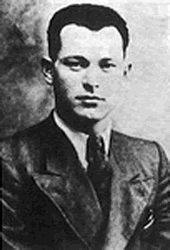
David Raziel (December 19, 1910 - May 20, 1941) was a fighter of the Jewish underground during the British mandate, and one of the founders of the Irgun
Born in Smarho? (now in Hrodna Voblast, Belarus), Vilna district in the Russian Empire, he immigrated with his family at the age of three to The British Mandate of Palestine, where his father became a Hebrew teacher at a Tel-Aviv elementary school. When the 1929 Hebron massacre broke out, he joined the Haganah in Jerusalem, where he was studying philosophy and mathematics at the Hebrew University. When the Irgun was established, he was one of its first members, and displayed outstanding military skills.
In 1937 he was appointed by the Irgun as the first Commander of Jerusalem District and a year later Commander in Chief of the Irgun. His term as leader was especially marked by violence against Arabs, including a sequence of market-place bombings.
On May 17, 1941 he was sent, with three of his comrades including Ya'akov Meridor, to Iraq on behalf of the British army to fight against al-Gaylani pro-axis regime. On May 20, a bomb from a German aircraft killed him and the British officer with him near an oil deposit in Habbaniyah. Meridor returned to Palestine and took over command of the Irgun.
In 1955 his remains were exhumed and transferred to Cyprus, and again in 1961 to Jerusalem's Mount Herzl military cemetery. His sister, Esther was later a member of the Knesset for Herut, the party founded by Irgun leader Menachem Begin. Comemoration
Ramat Raziel, a moshav in the Judean Mountains is named after Raziel, as well as many streets in Israel bearing his name in commemoration. The Israel postal service issued a stamp in his honor.[1]
Street named after him. Freedom fighter for Hagannah. Buried in special heroes cemetery,Mount Herzl , in Jerusalem.
Esther Naor (Rosenson/ Raziel)
Birth:
November 1911
Smarho?, Hrodzyenskaya Voblasts’, Belarus
Death:
November 11, 2002 (91)
Israel
Immediate Family:
Daughter of Avraham Rosenson/ Raziel and Bluma Rosenson/ Raziel
Wife of Yehuda Naor
Mother of David Naor; Aryeh ????' ???? Naor ???? and Efrat
Sister of David Razie
Esther Raziel-Naor (Hebrew: ???? ?????-????, 29 November 1911 – 11 November 2002) was a Revisionist Zionist, Irgun leader and Israeli politician. She was the sister of fellow Irgun leader, David Raziel.
Raziel was born in Smarho? (now in Hrodna Voblast, Belarus) in 1911, a year after her brother, David. Her household spoke Hebrew, as her parents refused to speak the more common Yiddish. In 1914 her family immigrated to Eretz Israel, after her father was offered a Hebrew teacher’s position at the “Tachmoni” school in Tel Aviv. However, when World War I broke out the family was deported by the Ottomans, along with other Russian nationals, to Egypt. She moved back to Russia and returned to Palestine in 1923, after an 8-year absence.[1]
In 1932 she joined Betar and organized the "National Cells". In 1935 she completed the Levinsky Teachers Seminary in Tel Aviv and moved to Jerusalem to work as a teacher, but was fired after being caught wearing a Betar insignia. She returned to Tel Aviv and took a "Lieutenants" course.[2] Irgun activity
In 1936, as the Arab Revolt broke, she joined her brother in the Irgun. She took a first aid course and in August she took participated in a reprisal. In 1939 she was became first broadcaster of the Irgun's underground radio station, Kol Zion Halohemet, as well as a writer for Hamashkif, its newspaper. In 1943 she was selected to be a member of the Irgun's command structure.[2]
On March 4, 1944, the police raided her parents' house and found the radio transmitter. She was arrested along with her husband, Yehuda Naor, and was jailed in Bethlehem (Yehuda was taken to Acre and later deported to Africa, where he stayed for four and a half years, until the establishment of the State of Israel). She was pregnant at the time of her arrest and on August 18, 1944, after a seven month internment, she was released and gave birth shortly after. She was placed under house arrest and was frequently investigated.[2]
On July 22, 1946, following the King David Hotel bombing, she was once again arrested and was sent to the Latrun detention camp, where she remained for several weeks. After her release she remained under strict surveillance and was prevented from continuing her underground activity.[2] Post-independence
After the United Nations Partition Plan for Palestine was accepted on November 29, 1947, she returned to Kol Zion. After the establishment of the State of Israel she joined Herut and was elected for it in 1 through 7 Knessets. Throughout her 25 year service she was a member of the Education and Culture Committee and the House Committee. In the election to the 8 Knesset she was replaced by Geula Cohen.[2]
She died on November 11, 2002, and was buried in Jerusalem.[3] Her son, Aryeh Naor, was Government Secretary under both of Menachem Begin's governments and his wife is Miriam Naor, a Supreme Court judge.
In preparation for my 17 year old sons trip to Poland in 2 weeks I stumbled upon your website and noticed that my great grandmother Masha Gordin Regensberg, daughter of R' Yehuda Leib Gordin, was missing. She was the sister to Bluma, Abba amd Zeev. Masha married my great Grandfather R' Chaim David Regensberg,in 1920, who was the son of Rav Dov Menachem Regensberg, the Chief Rabbi of Zembrov for 60 years, Masha and Chaim David moved to Chicago in the 20's with my grandmother who was a baby at the time.
My father was named for Yehuda Leib Gordin (Yehuda Leib Fishman a.k.a. Jerry), and my sister is named for my great grandmother Masha (Masha Fishman Wiesel A.K.A. Marci). My entire immediate family has since made aliya (Parents siblings and all our kids) all living in the Jerusalem area and we are very close with the Raziel/Naor cousins.
I was sad to see that my great grandmother was missing from the Gordin history when giving the details of Yehuda Leib Gordin's family, so I figured I would share.
Thanks so much!!
-Rocky (Fishman) Brody
Great grand daughter of Masha Gordin Regensberg
YITSKHOK GORDIN
http://yleksikon.blogspot.com/2015/07/yitskhok-gordin.html
YITSKHOK GORDIN (b. 1891)
He was born in Ruzhany (Ruzhenoy), Grodno region. He received both a traditional Jewish and a secular education. As a youngster he moved to Warsaw, and there he studied in a Russian high school. He was, however, expelled for illegal socialist activities. He worked among the Zionist socialists and territorialists. Over the years 1914-1917, he lived in the United States, where he studied at the University of Chicago. After the March [February] Revolution in 1917, he returned to Russia. He worked for the “United” (Fareynikte) socialist party in Byelorussia. He served as a member of the city council of Vitebsk and Mohilev. He moved to Warsaw in 1919, and there he worked as a teacher of Yiddish at Kalecki’s school for girls. Later he taught at Tsisho (Central Jewish School Organization) schools. At the same time he was active with the “United.” From 1921 he was a Communist. As an envoy of the Comintern, he visited China and other countries. For a long period of time he was under arrest in Poland, and he was subsequently exchanged for a prisoner in the Soviet Union. In 1928 he was on a Soviet Communist mission in Danzig and Berlin. He was arrested in 1937 in Russia and exiled to Kolyma in the distant north. He returned to Poland in 1946, and as a diplomatic emissary he visited the United States, and later still he was back in Poland. He began publishing in the party press of the Zionist socialists—Unzer vort (Our word) and Unzer veg (Our way); later, he served as editor and contributor to Literarishe tribune (Literary tribune) and other Yiddish publications of the Communist Party in Poland. Among his pseudonyms: Y. Lenski, Y. D., and Der Shvartser.
Sources: Zalmen Reyzen, Leksikon, vol. 1; Berl Kuczer, Geven amol varshe (As Warsaw once was) (Paris, 1954).
Posted by Joshua Fogel at 04:52
ABBA GORDIN
ABBA GORDIN (1887-August 1964) http://yleksikon.blogspot.com/2015/07/abba-gordin.html
He was born in Michalishok (P. Michaliszki), Vilna region. He studied in religious primary school and later spent two years in yeshiva, as well as in self-study of Hebrew, Russian, and other fields. He began writing in 1908. Together with his brother, Zev-Volf Gordin, he brought out in Hebrew Mikhtav galui al mukire ha?inukh (Open letter to those who respect education) (Vilna, 1908), 15 pp. He emigrated to the United States on February 6, 1926. He contributed pieces to Russian- and English-language newspapers, and in Yiddish to: Idishe kemfer (Jewish fighter), Tsukunft (Forward), Feder (Pen), Nyu-yorker vokhnblat(New York weekly newspaper), Fraye abeter shtime (Free voice of labor), Literarishe heftn(Literary notebooks), and Oyfsnay (Afresh)—all in New York; and in Hebrew to: Hadoar (The mail), Mabua (Fount), Megilot (Scrolls), Had hakevutsa (Echo of the collective), and Sefer hashana (Yearbook). Among his books (written with his brother Zev-Volf Gordin) [the following are translated titles originally written in Russian]: A System of Material and Relative Natural Moderation (Vilna, 1909); Imitative Rational Method (Vilna, 1909); Youth Pedagogy (Moscow, 1918); lectures and speeches (Moscow, 1919); and in Hebrew, Gan-teatroni (Theatrical garden), student’s book (Vilna, 1909); Gan-teatroni, teacher’s book (Vilna, 1909); Misderet hayeladim (The children’s typesetter) (Vilna, 1910); and in Yiddish, A megile tsu di yidn in goles (A scroll for the Jews in Diaspora) (Vilna, 1909); Undzere khiburim (Our treatises) (Vilna, 1912); Fonetishe ortografye (Phonetic orthography) (Vilna, 1913); Undzer kheder (Our schoolroom) (Vilna, 1913); Der yung-mentsh oder der finf-bund(The young man or the group of five), a dramatic poem in five acts (Vilna, 1913);Triumfedye (Triumphant) (Vilna, 1914). By himself he wrote in Russian: Why? (Moscow, 1917), 64 pp.; Anarchism in Spirit (Moscow, 1919), 159 pp.; Anarchism of Fantasy (Moscow, 1919), 128 pp.; Freedom de jure and de facto (Moscow, 1920), 39 pp.; Lower Individualism(Moscow, 1922), 229 pp.; Egotism, poems (Moscow, 1922), 40 pp.; Our program (Moscow, 1920), 39 pp.; in Yiddish, Yidishe etik (Jewish ethics) (New York, 1937), 320 pp.; Yidishkeyt(Jewishness) (New York, 1939), 335 pp.; Di froy un di bibl (Woman and the Bible) (New York, 1939), 188 pp.; Yidisher velt-banem (The Jewish world conception) (New York, 1939), 287 pp.; Moral in yidishn lebn (Morality in Jewish life) (New York, 1940), 288 pp.; Di sotsyale frage (The social question) (New York, 1940), 197 pp.; Sotsyale abergloyberay (Social superstition) (new York, 1941), 304 pp.; Di soydes fun der gezelshaft (Secrets of society) (New York, 1941), 320 pp.; Undzer banem (Our conception) (New York, 1946), 68 pp.;Denker un dikhter (Thinker and writer) (New York, 1949), 320 pp.; essays (New York, 1950), 224 pp.; Zikhroynes un kheshboynes (Reminiscences and reflections) (Buenos Aires, 1955), 460 pp; In gerangl far frayhayt (In the struggle for freedom), two volumes (Buenos Aires, 1956), 567 pp.; Yidish lebn in amerike (in shpigl fun f. bimkos verk (Jewish life in America, in light of Fishl Bimko’s work) (Buenos Aires, 1957), 341 pp.; in English, Communism Unmasked (New York, 1940), 320 pp. Gordin edited (in Russian) Anarkhie (Anarchy), a daily newspaper published by the Moscow federation of anarchists (Moscow, 1918); and Ob individualizme (On individualism), a monthly (Moscow, 1922); in Yiddish, Yidishe shrift(Yiddish writings), a quarterly anthology (1941-1946); in English, the monthly Clarion (New York, 1932-1934); and the quarterly Problems (New York, 1948-1950). He edited the work by Borekh Rivkin, A gloybn far umgloybike (A credo for the unbelieving) (New York, 1947), 256 pp.; and he authored the book Sh. yanovski, zayn lebn, kemfn un shafn (Saul Janovsky, his life, struggles, and creations) (Los Angeles, 1957), 584 pp. He also wrote under the pseudonyms: A. Keml, Meyers Esters, F. Meler, Gaskvin, and the like—in Yiddish; Gordi, Svetlov, Bloznetsov, and the like—in Russian; and Y. N. Howard and Benoyni, among others—in English. In the early years after the February and October Revolutions, Gordin with his brother, Zev-Volf, were active in the Moscow federation of anarchists.
Sources: Der lebediker, in Tog-morgn-zhurnal (New York) (December 12, 1954); Sh. Grund, in Keneder odler (Montreal) (May 17, 1955); Dr. A. Mukdoni, in Tsukunft (New York) (April 1955); Y. Birnboym, in Fraye arbeter shtime (New York) (September 23, 1955); Dr. N. Raziel, in Hadoar (New York) (April 27, 1955); Y. Varshavski, in Forverts (New York) (January 29 and September 30, 1956); Y. Botoshanski, in Di prese (Buenos Aires) (September 30, 1956; January 23, 24, and 26, 1958); Professor E. Naks, in Keneder odler (May 17, 1955; December 31, 1956); Naks, in Tsukunft (January 1957); M. Ginzburg, in Keneder odler (December 16, 1956); B. Parkman, in Dos fraye vort (Buenos Aires) (September 21, 1957); Y. Birnboym, in Di idishe tsaytung (Buenos Aires) (January 23, 1958).
Posted by Joshua Fogel at 06:05
YANKEV (JACOB) GORDIN
http://yleksikon.blogspot.com/2015/07/yankev-jacob-gordin.html
YANKEV (JACOB) GORDIN (May 1, 1853-June 10, 1909)
He was born in Myrhorod, Poltava region, Ukraine. His father, Ye?iel-Mikhl Halevi, was a well-to-do and eminent Hassid of the Chabad sect and simultaneously also a follower of the Jewish Enlightenment, and he gave his son both a traditional Jewish as well as a worldly enlightened education. As a youth, Gordin received his education at home with itinerant teachers and tutors. He studied Hebrew, Russian, and German, and on his father’s shelves of religious texts he discovered a few things that made a huge impression on him: the Russian translations of Edward Bulwer-Lytton’s English-language novel, What Will He Do with It?, and François Fénelon’s French novel, Les aventures de Télémaque (The adventures of Telemachus). He also found in his home the progressive Russian journals, Sovremennik(Contemporary) and Syn otechestva (Son of the fatherland) as well as Hebrew-language Enlightenment pamphlets. Around 1870 he began writing for the Russian press, and he was a frequent contributor to the south Russian newspapers, Odesskii vestnik (Odessa herald),Golos (Voice), Novorasiskii telegraf (New Russian telegraph), and Pravda (Truth). He was a member of a “circle of Little Russia” which set as its goal to liberate and detach “Little Russia” (Ukraine) from Russia. He mastered Ukrainian at the time, and even began to translate into Ukrainian the first chapter of Marx’s Das Kapital. In the Russian-language organ of his group—Zarya (Dawn)—he also began to write fiction. At age nineteen (in 1872), he married a young woman from a rich family and was compelled to make a career as a businessman, but as a dreamer and “enlightened” moralist with “populist” tendencies, he could not adapt to this life. He soon abandoned his dowry and found himself without a means of making a living. Gordin lost himself “across the world” and in his wanderings tried out various pursuits. He worked as a farmer, a stevedore at the port of Odessa, and an actor in a traveling Russian troupe. He later settled in Elizavetgrad. There he worked as a teacher in a Russian Jewish school (known as the “Russified Talmud-Torah”). For a time he also lived in Odessa. In both cities he took part in the world of journalism. He also wrote short stories and sketches, portraying in them images of real Jewish and Gentile lives. In 1880—using the pseudonyms “Yakov Mikhailovitsh” and “Ivan Kolyutshy”—he began to contribute to the progressive St. Petersburg journal Nedelya (The week) and to the southern newspapers Odesskie novosti (Odessa news) and Yelizavetgradskii vestnik (Elizavetgrad herald), and on these two newspapers he served for a time as unofficial editor. He published in Nedelya a series entitled “Types of Shtundists” [sectarian Christians]. He also wrote theater criticism, often changing his pen names: Kolovrat, Alfey, etc.
Also belonging to this phase of his career was the violent chapter of Gordin’s life tied to the sect known as the “Biblical Brotherhood.” In Elizavetgrad, then the center of the Russian Shtundists, Gordin had the opportunity to get to know quite well the people and ideals of this rationalist Evangelist sect which rejected dogmatic ritual in religion, built their faith on principles of humanitarian ethics, supported social equality, publicly opposed commercial exchange, and strongly believed in labor—especially, work on the land. The ideals of the Shtundists as well as their private lives greatly appealed to Gordin, and being a man of impetuous temperament and enormous energy, he decided to carry forth the principles of Shtundism into Judaism, to reform the entire Jewish way of life, and to transform the Jewish religion into a rationalistic, ethical-social teaching on the foundations of a pure biblical Jewishness. In January 1880 Gordin and a few of his adherents founded in Elizavetgrad the “Spiritual Biblical Brotherhood,” and some thirty people joined. They were popularly known as the “Bibleytses” or “Shtundares.” In 1881 the Brotherhood worked out the principles of its program, the essence of which were: religion is recognized only as a complex of ethical norms. They disavowed all religious dogma, as well as the immortality of the soul, repudiated religious ritual, including the wedding ceremony and that of circumcision, renounced the Talmud, and adhered solely to the Tanakh which they interpreted freely, all in the spirit of the times and of science. The Jewish population initially viewed the new sect with suspicion, but it became ever more hostile, especially—as was the case for Gordin—a short time after the April pogroms of 1881, when he wrote under the pen name “Brother in Bible” and published in the Kharkov Russian newspaper Yuzhnii krai (Southern frontier) a letter or an appeal “To Brother Jews,” in which he wrote that Jewish “monetary greed, sliminess, nerve, usury, trickery, and brokerage have brought the Russian people against us,” and to be rid of this hatred, the Jews needed to “yank out the rotten teeth with which they bite others and from which they suffer themselves.” His appeal ended with the turn of phrase: “Brothers, awaken and begin a new life.” This call provoked fury in the Russian Jewish press of the time and bitterness in the Jewish community. The Brotherhood disintegrated soon thereafter, and a number of its members began to agitate for emigration to the United States. Gordin fought against them. He left for a village in which he worked for three years on the land, living the life of a simple farmer. In 1884 he returned to Elizavetgrad and, together with Anna Pokrasova and Gr. Bernshteyn, rebuilt the Biblical sect which was legalized in 1885 by the authorities. Every Shabbat in their “prayer house” they would explicate passages from Tanakh in the spirit of Tolstoyism. Gordin had enormous success at such meetings with the power of his oratory. And, even with his deep, warm interest in the poor, unenlightened Jewish folk masses, Gordin was nonetheless still unable to bolster the Brotherhood, though he did succeed in founding in Odessa a circle of Shtundares, which Moyshe-Leyb Lilienblum would often criticize for its sectarianism, charging it with impure ulterior motives and aspirations to detach itself from Judaism and reach for bourgeois equal rights (Lilienblum also fought against Gordin’s sect in the columns of Razsviet [Dawn] and later, after Gordin’s death, inFraynd). Gordin made subsequent efforts to spread organizationally the activities of his sect, but without success. The government began to persecute the sect, and in 1891 he was himself compelled to emigrate to the United States. He had a plan to found a colony on a communistic basis in the New World, but nothing came of it.
On July 31, 1891, Yankev Gordin arrived in New York with his wife Anna and their eight children (she was pregnant at the time with their ninth). Precisely a month later, another child was born, and she would later give birth to another five—altogether she and Gordin had fourteen children. Soon after disembarking from the ship, Gordin joined the Jewish socialist colony in New York. Following the advice of Jewish socialists (especially, Philip Krantz), that the great majority arrived in America with their homely Russian and then switched to Yiddish, Gordin left with the same plan, and on August 21, 1891 he published in the New York socialist weekly Di arbayter tsaytung (The workers’ newspaper) his first item in Yiddish: ostensibly an extract from a letter about the three-day “pogrom in Elizavetgrad” in April 1881. The “letter” was signed “Yankev ben Mikhl.” Two weeks later in the same weekly, under Goldin’s full name, he published “Di oblave, oys dem idishn lebn in rusland” (The search, out of Jewish life in Russia) and one week later his humorous story “Pantole polge farn bezdn shel mayle” (Pantole Polge before the court on high) which was based on a theme similar to “Bontshe tsvayg” (Bontshe the silent), and later, in adapted form, it was frequently recited and performed by Yiddish actors on the theatrical stage. Thereafter in six issues of the newspaper, there was published his longer work, Vi azoy ikh bin gekhapt dem glik farn ek (How I seized happiness by the tail), “a tale of a Russian Jew.” Gordin even wrote impressions of Jewish workingmen’s lives in America, but he was more than anything else drawn to themes of life in the old country, which he depicted in short pieces and stories and also in his larger work, Di tsebrokhene harts (The broken heart), “a novel of Jewish life in Russia,” which was published serially in the same weekly. Yet, all of this could not by far suffice to maintain the well-being of his large household, and he sought out various means and ways of improving his difficult material condition. According to Hertz Burgin’s Di geshikhte fun der yidisher arbayter-bavegung in amerike, rusland un england(The history of the Jewish labor movement in America, Russia, and England) (New York, 1915), p. 321, he was obliged to try to publish (with Yitskhok-Ayzik Hurvits, in 1891) a Russian newspaper, Progress (Progress), but without success. Kalmen Marmor recounts in his book, Yankev gordin (Yankev Gordin), that he “did not succeed in devising such a newspaper, but only produced a description of it.” A short time later, after he had begun writing plays for the Yiddish theater, Gordin was the editor of the Russian weekly newspaperRusskie novosti (Russian news), published in New York from January 1 through September 3, 1893. There—writing under the pseudonyms Yan, Gordenko, Mikhailov, and Yankel Mikhelevitsh, among others—he wrote articles, notices, feature pieces, sketches, studies, and a treatise on a longer theme entitled [in English] “With Tolstoy in the Russian Famine,” as well as a translation of Ernest Renan’s Histoire du Peuple d’Israël (History of the Jewish people).[1] This newspaper lasted until issue 37, and due to financial difficulties then discontinued publication; Gordin then parted ways permanently from efforts to write in Russian in America.
In the last months of 1891, Philip Krantz proposed to Gordin that he write a play for the Yiddish theater, and to this end he brought Gordin together with the celebrated Yiddish actors, Yankev [Jacob] P. Adler and Zelig (Sigmund) Mogulesco. Gordin was just then working on his Russian newspaper, in which was described a story about someone deported to Siberia who subsequently escaped and was caught and sent back. “Here is the plot for a play”—Gordin said to Adler, and thus was born the play Sibirya (Siberia), for which Gordin received $100 (according to Z. Zilbertsvayg, Leksikon fun yidishn teater [Handbook of the Yiddish theater, vol. 1 (New York, 1931)]. Sibirya, “a living picture in four acts with a prologue,” was first staged on November 13, 1891 in Union Theater, and with it a new chapter opened in the history of the Yiddish theater. The play was never published as such. Nor, for that matter, did it raise such a great stir among the usual audience. It did, however, bring to the theater people such as had not as yet been seen there. Intellectuals began to go to Yiddish theater. Barely two months later, Gordin’s second play (also never published), Der pogrom in rusland (The pogrom in Russia), was staged in a second theater. In this play he also acted in the role of a Russian pristav (Tsarist police commissioner), because there was no actor in the troupe appropriate for the part. The two plays brought Gordin considerable recognition in the world of Yiddish theater, especially among the better Yiddish actors. When a group of the most eminent Yiddish stage actors (Yankev and Sarah Adler, Kenny Liptsin, and both of the Zilbermans) in 1892 joined together into a single troupe at Union Theater, they invited Gordin to be the playwright for their troupe and—according to the practice then current—placed their name over that of the theater itself. From that time forward, Gordin remained until the end of his life connected with the Yiddish stage, for which he either wrote or adapted, or simply translated from another language, three or four plays each year on average. In all, over the course of eighteen years of his playwrighting activities, he composed some 70-80 works. The majority of them had no enduring value and were never published. The better, original dramas did appear in various editions in New York, Warsaw, Przemy?l, and elsewhere. In virtually all of his plays, either the idea of it was taken from a well-known writer, or the entire plot line was borrowed, or it was simply a translation of a noted theatrical work. Oftentimes, the title was merely Judaized. Yet, even in the borrowed themes, Gordin created original Jewish types and an environment of a Jewish way of life.
For example, Der idisher kenig lyer (The Jewish King Lear) of 1892 has both its title and a portion of its plot take from Shakespeare; Di litvishe brider lurye (The Luria brothers from Lithuanian) and later Di gebrider lurye (The brothers Luria) of 1894 were built on the plot line of Shakespeare’s Romeo and Juliet; Der shvartser id, oder meyer yuzefovitsh (The black Jew, or Meir Yuzefovitsh) of 1895 was an adaptation of Eliza Orzenszkowa’s Meir Ezofowicz; Medea (Medea) of 1896 was a simple translation of Franz Seraphicus Grillparzer’s work; Forverts (Forward) of 1896 was a translation of a work by Sergey Mikhaylovich Stepnyak-Kravchinsky; Shloymke sharlatan (Shloymke, the charlatan) of 1896 was an adaptation of Alexander Nikolayevich Ostrovsky’s Bednost ne porok (Poverty is no disgrace); the opera Hernani (based on Victor Hugo’s drama [and Verdi’s opera]) emerged from Gordin as Kol shoyfer (The voice of the shofar) in 1896; Dvoyrele meyukheses (Dvoyrele, the aristocrat) of 1897 was adapted from Ostrovsky’s Grakh da beda na kogo ne zhivyot (No one is born in sin and sorrow); Reyzele, oder zelig-itsik der klezmer (Reisele, or Zelig-Itzik the musician) of 1897 was an adaptation of Friedrich Schiller’s Kabale und Liebe (Intrigue and love); Di shlekhte pastukher (The bad shepherds) of 1899 was a translation of Octave Mirbeau’s Les mauvais bergers; Di idishe geto (The Jewish ghetto) of 1899 follows closely Israel Zangwill’s Children of the Ghetto; Di shvue oder ronye di potshterke (The oath, or Ronye the postman) of 1900 was drawn from Gerhart Hauptmann’s Fuhrmann Henschel(Drayman Henschel). Even in his Di shkhite (The [ritual] slaughter) of 1900—with its rabbis, ritual slaughterers, and scholars—there is a scene taken from Ostrovsky’s Ne tak zhivi, kak khotshetsa (Don’t live as you like). And, even in his most original plays—such as Mirele efros(Mirele Efros, 1898), Got, mentsh un tayvl (God, man, and devil, 1900), Safo (Sappho, 1900),Kreytser sonata (Kreutzer Sonata, 1902), Khasye di yesoyme (Khasye, the orphan, 1903), Der unbekanter (The unknown man, 1905), Der meturef (The worthless one, 1905), Elishe ben abuye (Elisha, son of Abuya, 1906), and On a heym (Homeless, 1907)—one finds distinct influences from other well-known literary works, unquestionably drawn in significant number directly from translations and non-Jewish writers, such as: Maxim Gorky’s Meshchanye(Philistines), Deti solntsa (Children of the sun), and On Deck; Hauptmann’s Rose Berndt andVor Sonnenaufgang (Before sunrise); Tolstoy’s Vlast’ t’my (The power of darkness); Henrik Ibsen’s En folkefiende (An enemy of the people); and August Strindberg’s Fadren (The father). Out of material need, Gordin also wrote (occasionally under the pen name “Professor Yakobi in London”) plays of low artistic quality (shund or literary trash), dubbed “musical comedies” and operettas, such as the “historical opera” Di sheyne miryem un di gepeynikte (Beautiful Miriam and the tormented one) of 1900, according to A. Sh. Fridberg,Emek Haarazim (Vale of cedars). Gordin’s plays eliminated the wildly Germanized Yiddish that until him dominated the Yiddish stage, and he taught the actors to speak in a plain, natural Yiddish. While even Gordin did not understand in his own writing the distinction between Vilna Yiddish and his own stiff Elizavetgrad Yiddish, he still understood to be fastidious so that “Zelik-Itsig, the musician, and Nokhemtse, son of Devoyre and an itinerant teacher, Hershele Dubrovner, the scribe, and Khaldik, the peddler, would speak in a language that was fitting for each of them” (M. Vintshevski), and thus he introduced naturalness into speech and as well into the acting of the players who had ceased walking around the stage with the old Shomer-Lateiner-Hurwitz pride. He created a school for the better Yiddish actors, and with gratitude and respect they performed all his plays, occasionally when it was at the expense of ticket sales. A strong personality, a widely educated man with an extraordinary sense of the stage from his very first play, later also with a firm dramatic talent—and moreover a high moral searcher and fighter for truth—Gordin was as if called to this historical mission in the Yiddish theater. With Mirele efros he launched a new epoch in Yiddish theater. This play, just as was the case with Got, mentsh un tayvl, Kreytser sonata, Di shkhite, Khasye di yesoyme, Der unbekanter, and On a heym, have remained classic works in the Yiddish theatrical repertoire. With them Gordin wrote not only for the stage but also for literature.
From 1895 to 1908, the best Yiddish theaters in New York—first among them, Jacob Adler and Kenny Liptsin’s (Thalia Theater)—performed Gordin’s plays, and Gordin throughout the years wrote his theatrical works especially for the actors in these troupes (Jacob and Sarah Adler, Dovid [David] Kessler, Sigmund Mogulesco, Morris [Maurice] Moskevitsh, Kenny Liptsin, both Thomashefskys, Berta Kalish, Bina Abramovitsh, Leon Blank, both Feinmans, and others).
Many of Gordin’s staged productions had no success whatsoever, and they were removed from the repertoire. Others, such as Elishe ben abuye, for example, which was a failure in 1906, was revived many years later and performed with great success. Gordin’s final, highly work that gained success was On a heym, a play drawn from American Jewish life (it premiered in 1907 in the Grand Theater). Thereafter, Gordin, who was by this time quite ill, made a voyage to Europe with the goal of improving his health, and when he returned he staged (December 1907) his play Goles galitsye (Exile in Galicia) which was also dropped from the repertoire. This was, indeed, a difficult time for better works on the stage. Gordin was without a theater and, although he had already received $2000 for a work of his own, he nonetheless felt as though the earth had begun to disappear beneath his feet. “The great multitudes of newly arrived immigrants,” wrote B. Gorin, “were unable to digest high-quality drama, and the directors struggled ever so hard to win over a substantial audience to their side.” “The actors at the Thalia,” explained Bessie Thomashefsky, “were jealous of our intake; they turned art into prison, sent ‘God, Man’ to the ‘Devil,’ and began to deliver the goods to lowly popular tastes, to a worthy public, they claim.” Gordin’s last play was titled Dementya amerikana, oder der vanzin nokh gelt (American dementia, or the folly of money)—staged in Thomashefsky’s People’s Theater on November 26, 1908—and it garnered no success. In his last play Gordin raised the issue of the great boom in real estate (agitated prices for land and homes), which at the time had arrived suddenly in Brooklyn and the Bronx. The play was completely original, and it summoned great applause at the premier as well as from the critics of the entire Yiddish press in New York. It could not, however, be sustained on the stage—the audience did not materialize. “The failure ofDementya amerikana was a signal,” noted B. Gorin, “that the epoch of better drama had come to an end.” Gordin did not live long after this. He had suffered from cancer since 1907. Late 1908 to early 1909, he spent a short time in Beth Israel Hospital in New York. People then moved him to his home, and he died of a hemorrhage later that night. His last words were: “Finita la commedia” (The farce is over). His death aroused pain and sadness throughout the Jewish population in New York. Hundreds of thousands attended his funeral which began at the Thalia. In the Forverts (Forward) of June 12, 1909, Morris Rosenfeld wrote: “I see him tramping down over the streets like a palm tree. His aristocratic beard hangs with a festive honor over his wide shoulders; his eyes, like two bits of fire, sharp as the slaughterer’s knife; in his right hand, a wand, and in his left hand one of his plays.” In an editorial in the same issue of this newspaper, A. Liessin wrote: “One always expected greatness from him…. He was, however, a romantic, and this explains much about his career, full of misunderstanding and fate.” One can see that by “misunderstanding and fate” Liessin had in mind literary and personal conflicts as well, which for many years carried on between Gordin and Abe Cahan, editor of the Forverts. The conflict began in 1895 with the premier of Gordin’s play Der rusisher yid in amerike (The Russian Jew in America), in which he traced a Jewish union leader, Huzdak, a man who has sold his soul, who in the face of all the complaints of the laborers about their treatment in the union, always responds: “What do I need brains for when I’ve got a Constitution?” This very phrase became a classic itself. People called it “Huzdakism.” At the premier performance, Cahan exclaimed aloud in Russian from his theater box: “That’s a lie!” From that point forward, a conflict ensued between the formerly two good friends, which later developed into an open, long, bitter, but very serious and instructive debate concerning theater generally and Gordin’s writings in particular. The entire Yiddish press of the day became involved in the debate. Gordin polemicized with his adversary in the pages of Varhayt (Truth) and other newspapers and magazines, through his own journal Di dramatishe velt (The dramatic world) (New York, September and October, 1897), through his popular conversations with the audience at the theater between the acts of his plays, as well as through dozens of his public lectures which regularly drew hundreds of listeners. After his death, the Thalia mounted (on December 30, 1910) a surviving play by him, entitled Di mume fun varshe (The aunt from Warsaw), “melodrama in four acts with music from Rumshinsky.” Later still, in November 1918, Thomashefsky staged his second surviving play, Vilde kozakn (Wild Cossacks), “or Jews and Cossacks, Little Russian [Cossack] music by Y. Rumshinsky.” Neither play was a success. The former was never published, and the theme of the second was detailed in Y. Entin’s review of the performance (Varhayt, New York, December 3, 1918). It should also be possible to locate among Gordin’s remaining manuscripts the play Di kinder geyen (The children go), which has, however, till now not as yet been published.
In all the years that Gordin devoted to his intensive and urgent writing for the theater, he also wrote stories which were published in a variety of Yiddish newspapers, such as: Arbayter tsaytung, Forverts, Fraye arbeter shtime (Free voice of labor), Di tsukunft (The future), and Varhayt, among others. In 1908 the publishing house of “The International Library” (A. M. Yevalenko) in New York published a volume entitled Yankev gordins ertseylungen (Yankev Gordin’s stories), 272 pp., with “a short notice” by Y. Gordin. The same publishing house in 1903—in its series “Lebns-bashraybungen fun barimte menshn” (Life stories of eminent persons)—brought out Gordin’s booklet Volter als mensh un denker(Voltaire as man and thinker), 32 pp. In 1910 the Hebrew Publishing Company in New York brought out the four-volume set Ale shriftn fun yankev gordin (All writings of Yankev Gordin)—vol. 1, 252 pp.; vol. 2, 298 pp.; vol. 3, 301 pp.; vol. 4, 314 pp.—which included his stories, impressions, and sketches of Jewish life in the old country and in America, as well as his criticism, general thinking (“Troyerige gedanken” [Sorrowful thoughts], in vol. 3), and treatises concerning “Groyser velt-drama” (Great plays of the world) and “Drama un dramaturgn” (Plays and playwriting) in vol. 4. The first volume opens with an introduction by M. Vintshevski, “Yankev gordin der folks-lerer” (Yankev Gordin, the people’s teacher), 13 pp., which one can read even today with interest. In 1911 the publishers “Circle of Jacob Gordin’s Friends” in New York began bringing out (according to a subscription campaign)Yankev gordins dramen (The plays of Yankev Gordin). Only two volumes appeared (193 copies in a splendid edition): vol. 1 included Got, mentsh un tayvl, Elishe ben abuye, Der meturef, Safo (with a foreword by H. Zolotorof), and Oyf di berg (On the mountains); vol. 2 included Mirele efros (with a prologue in verse by M. Vintshevski), Kreytser sonata, Di emese kraft (The true power), Der unbekanter, and On a heym. With each drama the actors who appeared in the premiers are listed. The newspaper Tog (Day) in 1907 published Gordin’s one-act plays, and later that year there appeared in book form Yankev gordins eyn-akters(Yankev Gordin’s one-act plays), seventeen in all, 249 pp., with a preface entitled “Di oyfgabe un der tsvek fun eyn-akters” (The task and purpose of one-act plays) by Gordin’s son Alexander. One of these one-act plays—Der rusisher amerikaner farayn mit breyte idealn(The Russian American union with broad ideals)—Y. Entin translated from Russian. In November 1901 Suvenir (Souvenir) appeared in New York, “for Yankev Gordin’s ten-year jubilee” (40 large, densely printed pages).
Gordin was also a community leader throughout the time he lived in New York. Just after his arrival there, he approached the Jewish social democrats who clustered aroundArbayter tsaytung. When Morris Vintshevski in 1895 founded Emes (Truth) in Boston, Gordin was his closest collaborator on the newspaper and in the struggle that Vintshevski was leading in the Jewish wing of the Socialist Labor Party (S.L.P.). In 1897, Gordin, together with Meyer London, Yitskhok-Ayzik Hurvits, and others, was among the founders of the first branch of the Socialist Party (S.P.), led by Eugene V. Debs. That same year, the society “Fraye yidishe folks-bine” (Free Yiddish people’s theater) was founded in New York, with the goal of working toward a better Yiddish theater, and Gordon soon became the soul of this new organization—with his lectures as well as with his energetic organizational activities. He later founded the Educational League, and for many years he devoted his talent, temperament, energy, and will power to this organization. In the first years of the Forverts, he was one of the main contributors to the newspaper. Between 1901 and 1906, he together with M. Vintshevski took an active part in campaigns on behalf of the Bund in Russia. In April 1908 he was a member of a group that was mailed an invitation to the historic language conference in Czernowitz.
Sources: There exists no complete listing of all the plays by Yankev Gordin. B. Gorin lists sixty-three of them in his Geshikhte fun yidishn teater (History of the Yiddish theater), vol. 2 (reprinted in Zalmen Reyzen’s Leksikon, vol. 1); a list of his published plays in Yiddish and in translation into other languages, as well as a list of the majority of his staged plays, can be found in Z. Zilbertsvayg, Leksikon fun yidishn teater, vol. 1; this can also be found in the book Yankev gordin by K. Marmor (New York, 1953). Gordin’s dramatic works have been translated into Russian, Polish, Hebrew, English, German, Ukrainian, Hungarian, Italian, and Spanish. Films have been made from his plays, and they have also been performed on the radio—see Yankev Mestl, “Yankev gordins pyesn in film, radyo un af farsheydene shprakh” (Yankev Gordin’s plays in film, radio, and in various languages) and N. Meyzil, “Yankev godin af rusish, poylish un hebreyish” (Yankev Gordin in Russian, Polish, and Hebrew), in Marmor’s book, pp. 209-26.
The literature on Gordin is extremely rich and diverse. Bibliographies of this literature have thus far been compiled by Zalmen Reyzen in his Leksikon, vol. 1; Z. Zilbertsvayg in Leksikon fun yidishn teater, vol. 1; Shmuel Niger, Dertseylers un romanistn(Storytellers and novelists) (New York, 1946), pp. 93-203; Niger, in Algemeyne entsiklopedye(General encyclopedia), “Yidn H” (New York, 1957), pp. 120-21; Y. Yeshurun, in Fraye arbeter shtime (New York) (May 22, 1953); Yeshurun, in K. Marmor’s book, pp. 227-41. To these bibliographies should be added: Di briv fun and tsu yankev gordin (The letter from and to Yankev Gordin), published by Moyshe Shtarkman, in Yivo-bleter (Vilna) 3.2 (February 1932) and Fraye arbeter shtime (May 22 and June 19, 1953; January 1 and 29, 1954); Dr. Y. Shatski, in Yivo-bleter 38 (1954), pp. 303-12 (exchange of letters between Gordin and the British journalist Simeon Stronsky and the American poet Edward Markham). As yet unmentioned in all the above bibliographies: A. Volf-Yosni, in Letste nayes (Tel Aviv) (August 21, 1953); E. Shulman, in Frayland (Paris) 2 (10) (June 1954); K. Marmor, in Yidishe kultur(New York) (July 1954); Y. Turkov, in Yidishe shriftn (Warsaw) 5 (85) (1954); H. Rogof, Der gayst fun forverts (The spirit of the Forverts) (New York, 1954), pp. 103-4; Y. Sh. Herts, Di yidishe sotsyalistishe bavegung in amerike (The Jewish socialist movement in America) (New York, 1954), pp. 74, 124; Yankev Glatshteyn, in Idishe kemfer (New York) (October 8, 1954); Y. Entin, in Tsukunft (New York) (December 1954 and January 1955); L. Kobrin, Mayne fuftsik yor in amerike (My fifty years in America) (Buenos Aires, 1955), pp. 285-93; Dr. A. Mukdoni, In varshe un in lodzh (In Warsaw and in Lodz), vol. 1 (Buenos Aires, 1955), see index; Y. Rodak, Kunst un kinstler (Art and artists) (New York, 1955), p. 58; N. Meyzil, ed. and comp., Amerike in yidishn vort, antologye (America in the Yiddish word, an anthology) (New York, 1955), see index; A. Dimov, in Tsukunft (November 1957); Dr. A. Foyrshteyn, inHatsofe (Tel Aviv) (Kislev 1957); Dimov, Dos yidishe vort (Santiago, Chile) (December 20, 1957); A. A. Roback, The Story of Yiddish Literature (New York, 1940), pp. 168-72.
Yitskhok Kharlash
From: Valerik Punk <valerikpunk@gmail.com>
Date: Sun, Oct 30, 2016 at 1:22 PM
Subject: Wolf Gordin
To: egl.comments@gmail.com
Hello! Can you help me, please? I am making a publication about Wolf (Zeev) Gordin, brother of Abba Gordin. I found a lot of materials, but it date from before 1925. Maybe you have some info about Wolf Gordin after 1925? I know exactly that he were been arrested in 1925, and I found info that he emigrate in USA, but its not true, I guess. Maybe some photos of him? I have nothing.
If you wonder, I can give you a part of dissertation with info about 1925 and a book of Wolf Gordin. So, help me if you can.
Dear Valerik,
You should try to get in touch with the grandchildren of his sister Bluma. Here is some information about his niece;
Esther Raziel-Naor (29 November 1911 – 11 November 2002) was a Revisionist Zionist, Irgun leader and Israeli politician. She was the sister of fellow Irgun leader, David Raziel.
Raziel was born in Smarho? (now in Hrodna Voblast, Belarus) in 1911, a year after her brother, David. Her household spoke Hebrew, as her parents refused to speak the more common Yiddish. In 1914 her family immigrated to Eretz Israel, after her father was offered a Hebrew teacher’s position at the “Tachmoni” school in Tel Aviv. However, when World War I broke out the family was deported by the Ottomans, along with other Russian nationals, to Egypt. She moved back to Russia and returned to Palestine in 1923, after an 8-year absence.[1]
In 1932 she joined Betar and organized the "National Cells". In 1935 she completed the Levinsky Teachers Seminary in Tel Aviv and moved to Jerusalem to work as a teacher, but was fired after being caught wearing a Betar insignia. She returned to Tel Aviv and took a "Lieutenants" course.[2] Irgun activity
In 1936, as the Arab Revolt broke, she joined her brother in the Irgun. She took a first aid course and in August she took participated in a reprisal. In 1939 she was became first broadcaster of the Irgun's underground radio station, Kol Zion Halohemet, as well as a writer for Hamashkif, its newspaper. In 1943 she was selected to be a member of the Irgun's command structure.[2]
On March 4, 1944, the police raided her parents' house and found the radio transmitter. She was arrested along with her husband, Yehuda Naor, and was jailed in Bethlehem (Yehuda was taken to Acre and later deported to Africa, where he stayed for four and a half years, until the establishment of the State of Israel). She was pregnant at the time of her arrest and on August 18, 1944, after a seven month internment, she was released and gave birth shortly after. She was placed under house arrest and was frequently investigated.[2]
On July 22, 1946, following the King David Hotel bombing, she was once again arrested and was sent to the Latrun detention camp, where she remained for several weeks. After her release she remained under strict surveillance and was prevented from continuing her underground activity.[2] Post-independence
After the United Nations Partition Plan for Palestine was accepted on November 29, 1947, she returned to Kol Zion. After the establishment of the State of Israel she joined Herut and was elected for it in 1 through 7 Knessets. Throughout her 25 year service she was a member of the Education and Culture Committee and the House Committee. In the election to the 8 Knesset she was replaced by Geula Cohen.[2]
She died on November 11, 2002, and was buried in Jerusalem.[3] Her son, Aryeh Naor, was Government Secretary under both of Menachem Begin's governments and his wife is Miriam Naor, a Supreme Court judge.
Ester Raziel-Naor (Raziel) MP
Gender:
Female
Birth:
November 29, 1911
Smorgon'
Death:
November 11, 2002 (90)
Israel
Immediate Family:
Daughter of Avraham Mordechai Raziel-Rosenson and Bluma Rosenson/ Raziel
Wife of Yehuda Naor
Mother of Aryeh Naor; David Naor and Efrat Naor
Sister of David Raziel Commander Etzel and Pnina Raziel
His great nephew;
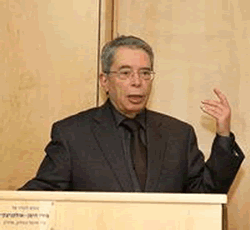
Aryeh Naor
Gender:
Male
Birth:
1940
Immediate Family:
Son of Yehuda Naor and Ester Raziel-Naor
Husband of Miriam Naor
Father of Michael Naor and Naftaly Naor
Brother of David Naor and Efrat Naor
His wife;Miriam Naor (born October 26, 1947) is President of the Supreme Court of Israel. Naor will serve until September 2017, when she reaches the mandatory judicial retirement age of 70.[1]
Born in Jerusalem in 1947, Naor graduated from the Hebrew University’s law school in 1971 and clerked for Supreme Court justice (later Chief Justice) Moshe Landau. She worked on constitutional issues in the State Attorney’s Office under Mishael Cheshin, who would later be appointed Deputy Chief Justice.
In 1980 she won her first judicial appointment to the Jerusalem Magistrate’s Court. Later in the 1990s, she served as one of the judges who eventually convicted Shas chairman Aryeh Deri on bribery charges. She became a permanent justice on the Supreme Court in 2003.
Naor hails from a family rooted in the Revisionist Zionist tradition. Her husband, Aryeh Naor, served as Prime Minister Menachem Begin’s cabinet secretary from 1977 to 1982. Her mother-in-law, Esther Raziel-Naor, was a long-serving member of Knesset for Herut(the precursor to Likud) — from 1949 to 1973. Her son Naftali — whose godfather was Menachem Begin — ran unsuccessfully in Likud primaries.
From: Dana Shavit <shavit.danna@gmail.com>
Date: Fri, Jan 20, 2017 at 10:03 AM
Subject: Gordin Family Info
To: egl.comments@gmail.com
Hi Eilat,
My name is Dana Shavit, I live in Mevasseret Zion, Israel. My Son was researching our family tree with my dad and doing a quick google search I found your site.
My Grandmother has Eva(Chava) Gordin, and the way our branch probably fits in with all the info on your page is in this paragraph (quoting your page...)
"Mendel’s son Aba Gordin survived
and lived in Korsovka. He possessed a Sefer Torah and took upon
himself to organize religious services for the small community that
survived the Holocaust"
To the best of my knowledge Aba Gordin is my grandmother's brother and he lived well into the 1980's. Mendel Gordin in their father, according to the family tree we drew.
I hope this is of interest to you and I will be happy to answer any questions,
Dana Sahvit.
From: Judith Greengus <judegreengus@g.....com>
Hi,
I wanted to thank you for your wonderful and informative web pages; I believe that we are distant cousins as my great grandmother was Liesha Gordin, daughter of Moshe and Sara Gurevitch Gordin. All the best,
Judith Greengus
NYC
From: Libi Yeheskeli
Date: Wed, Feb 14, 2018 at 6:34 AM
Subject: Esther Gordin
Hi Eilat,
Your website about the Gordins in Riga I saw this picture attached.
This is my great grandmother Esther Gordin. My grandfather is Moshe Gordin.
Can I ask how you came about this picture? So interesting!
Thanks!
Libi
Dear Libi,.
I found the picture in yad Vashem. I also added it to a tree on Geni. I am trying to connect all the Gordins.from Riga. Let me know if I made mistakes
Ester Yente Gordin (Astanovski)
Gender:
Female
Birth:
1870
Death:
1941 (71)
Latvia (murdered by the Nazis)
Immediate Family:
Daughter of Tana Astanovski
Wife of Elkhanan- Hone-aron- Natan Gordin
Mother of Tova Dina Gordin and Moshe Gordin
Sister of Masha Lachman
Esther Gordin was born in Russia (USSR) in 1870 to Tana and Rachel. She was married to Aharon. Prior to WWII she lived in Dagde, Latvia. During the war she was in Dagde, Latvia. Esther was murdered in 1941 in Dagde, Latvia. This information is based on a Page of Testimony (displayed on left) submitted by her son.
